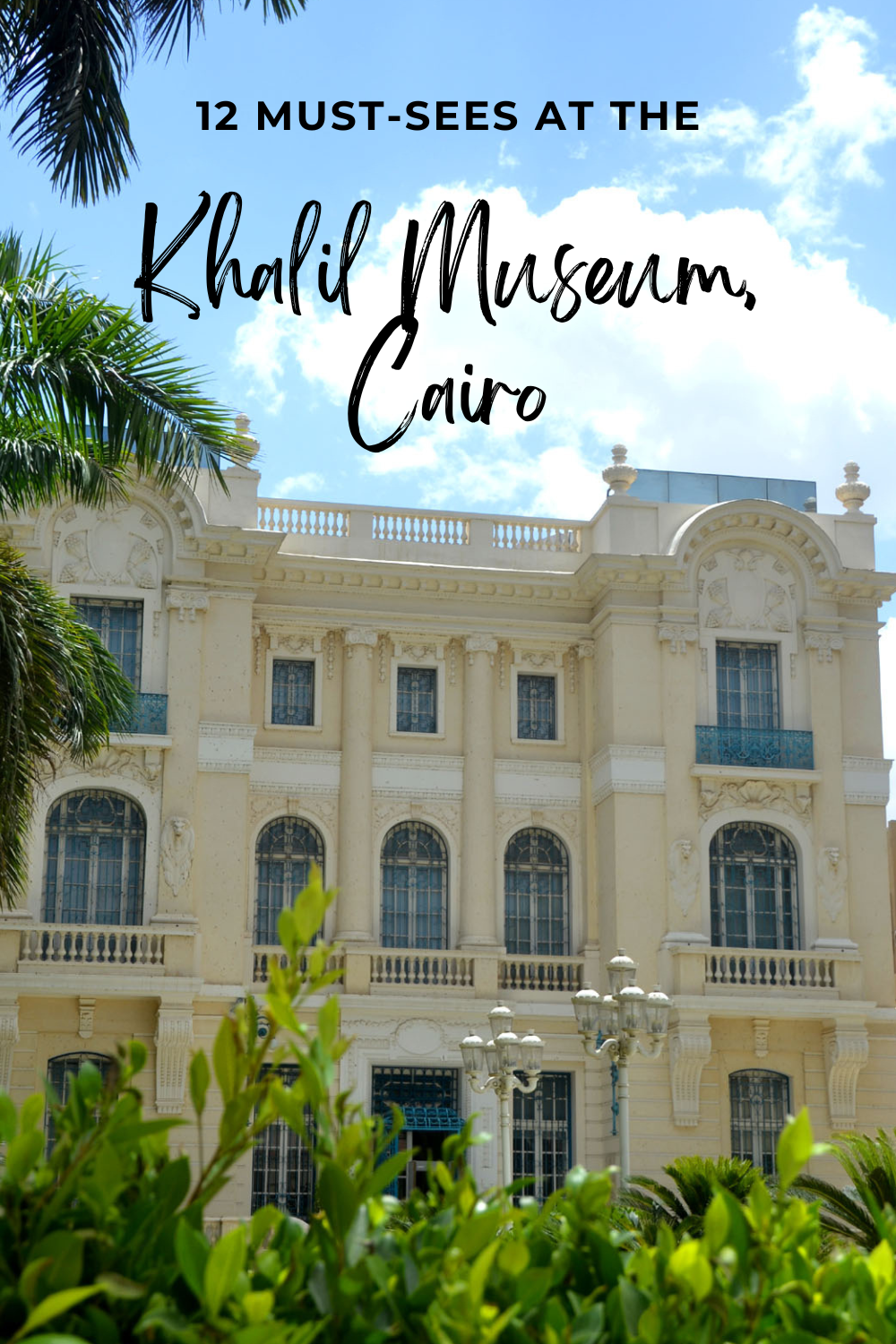12 Must-See Things At The Khalil Museum
13 min readThe Khalil Museum is a real Cairo hidden gem inside a Nile-side palace that houses an Impressionist collection to rival European exhibits. The Khalil Museum isn’t what you’d expect from a city known for historic mosques and Ancient Egyptian artifacts. But it’s a true Cairo hidden gem with its vast collection of Impressionist paintings, porcelain and miniatures. Tucked inside a 1905 palace along the Nile River, the Khalil Museum has finally opened after a decade-long closure and the high-profile theft of a priceless Van Gogh. And if you’re an art lover, the Khalil Museum is an absolute must-see on your Cairo itinerary. It’s a fascinating look into Egypt’s royal history. And it’s a rare chance to see masters like Monet and Renoir in a more intimate setting. Museum history The Khalil Museum is a touching labor of love by an Egyptian politician and his French wife, brought together by their shared love of art. The museum contains a massive collection of Impressionists gathered by the couple over the years and amassed inside their Nile-side palace. Mahmoud Khalil and his wife purchased the neo-Classical palace in 1915 for their family residence. But they never dreamed it would someday become a destination for art lovers. Born in Cairo in 1877, Khalil studied law at the Sorbonne in Paris. There he met Emilienne Luce, a French music teacher and theater performer. She instilled her love of collecting art into Khalil. The couple married and settled down in the Cairo palace that would soon fill with their art collection. Khalil was a life-long politician who served twice as Egypt’s prime minister. He also worked tirelessly to strengthen cultural ties between Paris and Cairo. Encouraged by his wife, Khalil spent years amassing his collection of priceless Impressionist paintings and objects d’art. Before his death in 1953, Khalil left the palace and its enormous collection to his wife. She then left it to the Egyptian government to be turned into a museum. Today the museum is a testament to the couple’s life-long passion for the arts. The missing Van Gogh The museum was mostly visited by arts lovers in-the-know and remained off the beaten tourist path for years. But it gained international attention in 2010 when Van Gogh’s Poppy Flowers (1887, above) was cut from its frame and stolen from the museum. Egypt declared a state of emergency in all of its airports and several high-ranking officials faced criminal charges for allowing the theft to occur. But the painting – finished just a few years before Van Gogh’s death – was never recovered. What’s even more strange is the fact Poppy Flowers had been stolen from the Khalil Museum once before – in 1978. After that theft, the painting was recovered a decade later in Kuwait. It was then returned to the museum under shady circumstances that left some art critics speculating that the recovered painting was actually a fake. After that string of scandalous thefts, the museum closed for a decade and underwent extensive renovations (including a new security system). It finally opened again to the public in 2021. Though the guide books and tourist crowds haven’t caught up yet. Which means it’s the perfect time to visit. Inside the Khalil Museum A long walkway lined with rubber trees and Cuban royal palms leads to the museum’s striking Art Nouveau facade. Inside, the security is almost comically strict. You leave your ID at the desk, and your bags are put away in a locker to be picked up when you leave. There are no DSLR cameras or video allowed. And this means you can only take photos with your phone camera. Try and sneak in a TikTok or two (like a pair of friends did when I was there), and you’ll get a loud announcement over the intercom telling you to cut it out. The announcements are loud enough to make you jump. But eventually they just become amusing – annoying, but not enough to spoil your visit. Museum highlights The Khalil Museum boasts more than 300 paintings and 50 sculptures from the 17th to 20th century. The museum has labels on most paintings that give the artist’s name, painting title and medium. But many other objects (like the vases, textiles and boxes) are not yet labelled. So where do you begin to explore this vast collection of Impressionist art and sculpture? Here are the must-see highlights at the Khalil Museum you shouldn’t miss: 1. The Rodin sculptures The ground floor has a dramatic Auguste Rodin (1840-1917) statue titled The Call To Arms (above) displayed under a glistening chandelier. The statue is surrounded by some unlabeled vases, Ottoman-era plates and a Belgian wall hanging. The magnificent sculpture shows a dying French soldier leaning against a winged angel for support. The sculpture commemorates the courage of Parisian fighters during the Franco-Prussian War while defending their city against the Germans. There’s also a plaster sculpture of French novelist Balzac, done in rougher lines that portray the bulky realist writer. The stout body is sculpted with the same kind of honesty that Balzac used in his novels. The museum’s collection also includes bronze casts of beloved Rodin sculptures like The Thinker (above). This iconic sculpture symbolizes philosophy – and used a muscular French prizefighter as the model. There’s also a bronze cast of the Bust of Victor Hugo, which the French novelist sat for in short half-hour sessions. Rodin completed his studies from the porch of Huge’s Parisian home. There, the sculptor looked up at Hugo through the window to complete his sketches. And don’t miss the masterful Youth Triumphant (above), a bronze cast that depicts a young woman resting in the arms of an elderly woman and kissing. The older woman is thought to symbolize Fate, while youth is seen overcoming age. 2. The Corot landscapes The museum’s collection of Corot landscapes set the stage for the looser brush work of the Impressionists. Jean-Baptiste-Camille Corot (1796-1875) was a prolific artist of the Neo-Classical tradition whose latter landscapes influenced the plein-air (outdoor) style of Impressionism. Corot’s landscapes at the Khalil Museum depict windswept trees, stormy skies, moonlit water and dramatic cliffs that showcase his moody style and use of natural light. Corot studied painting for years but was slow to gain public recognition. Eventually artists like Delacroix recognized his talent. And Corot’s increasingly impressionistic style sealed him a place in French art history. In his latter years, Corot’s landscapes turned dreamier with more fluid strokes and atmospheric lighting. Corot taught a slew of art students and supported others with a nearly proverbial kindness. He bought a house for Daumier, a painter who’d gone blind, and supported Millet’s widow and children financially. Corot was a tremendous influence on Impressionists like Sisley and Renoir with his free-flowing brushwork and depiction of natural light. 3. The Orientalist paintings From vibrant street scenes of Old Cairo to serene Nile landscapes, the museum’s collection of Orientalist paintings offers a view of Egypt through rose-colored glasses. Old Cairo (above, top) by Prosper Marilhat (1811-1847) depicts a covered market in the foreground with far-away domes, palms and a minaret in dramatic light. Marilhat painted most of his work based on sketches he completed in Egypt in 1831-32. His paintings of Cairo’s monumental mosques and landscapes made French viewers yearn for an Orient they’d never seen. Cairo’s Streets (1919, above, bottom) by Marie-Gabriel Biessy (1854-1935) portrays a bustling street scene with a towering Ottoman-style minaret and modern apartment buildings. The wagon carrying leafy vegetables can still be seen today in the city’s working-class districts. Biessy traveled widely across Senegal and Egypt to paint Orientalist landscapes. He served as the director of Cairo’s college of fine arts towards the end of his career. The Nile in Upper Egypt (above) by Eugene Fromentin (1820-1876) likely depicts Nubian women in various states of undress gazing out over the river. The painting is one of the largest in the Orientalist collection and showcases Fromentin’s signature striking composition. Fromentin painted several scenes of Egypt. But he’s best known for his studies of Algeria, which he visited extensively and portrayed with an unprecedented accuracy. 4. Monet’s Water Lilies The museum has a stunning collection of Monets including paintings from his famous Water Lilies series. Claude Monet (1840-1926) painted the iconic series of nearly 300 paintings at his Giverny garden during the last thirty years of his life. The Khalil Museum has two of them. The first is Bride over the Water-Lilies (above, top, 1899) depicting the famous curved Japanese footbridge at Giverny over a pond framed by a weeping willow. It’s thick with bold colors that suggest a late summer sunset. It’s also one of the early paintings in the Water Lilies series, which Monet painted from the late 1890s until his death in 1926. The second painting is the ethereal Water-Lilies (above, bottom, 1907) done in soft pastels and well-blended strokes. The painting is nearly abstract with its emphasis on light and atmosphere over form. Hugely influential to generations of artists, Monet’s Water Lilies paintings are some of the most recognizable works of 20th-century art. They opened the door for abstract art and captured the garden under ever-changing conditions. The last paintings in the series are in startling reds and oranges, done when Monet was diagnosed with a cataract. Interestingly, Monet imported the water lilies for his garden at Giverny from Egypt and South America. The museum has a few more gorgeous Monets including a dreamy L’Aiguille de Cléopâtre et Charing Cross Bridge (above, left, 1900) overlooking the water, and Argenteuil, bateaux au long de la berge depicting a row of sailboats along a rustic river bank. 5. The Gauguins The museum has some striking Gauguins that depict exotic landscapes in the artist’s trademark luscious colors. Paul Gauguin (1848-1903) is a post-Impressionist artist known for his bold colors and depictions of French Polynesia, where he lived for ten years (and had notorious sexual relations with teenage girls). The museum’s works showcase Gauguin’s use of Symbolism and color. Life and Death (above, 1889) is a work of contrasts. The sensual and fleshy figure of a red-haired woman takes up half the canvas. Her figure is contrasted with the darker and despairing body of a black-haired woman, sitting enclosed by jagged cliffs and a stormy sea. Scène à la Dominique (above, Scene in Dominica) shows a scene of everyday Polynesian life that’s so often featured in Gauguin’s work. The painting features two women in the forefront lounging on pink sand beside orange-speckled water. Gauguin is a proverbial figure who lived for his art. He left behind his wife and children in Copenhagen to live in Tahiti and paint. 6. The Sisley landscapes The museum’s collection of Sisley landscapes showcase the Impressionist painter’s tranquil and expressive style. Alfred Sisley (1839-1899) was a prolific Impressionist who often painted plein air (outdoors, instead of in a studio). His best-known landscapes portray scenes of the River Thames and landscapes at Moret-sur-Loing. A British national who spent most of his life in France, Sisley is known for his soft, pastel palette and gently atmospheric landscapes. Seine at Sunrise (above, top) is a textbook Impressionist landscape with its thick brush strokes, milky skies and softly-blended grass. It’s a free-flowing effort to capture the ever-changing light. Moret in Autumn (above, middle) features a row of tall, pastel trees reflected hazily in the water. Wood Storehouse (above, bottom) is a soft landscape in minimal tones depicting cloudy skies, windblown trees and rural serenity. 7. The Millet drawings The Khalil Museum’s Millet drawings illustrate his revolutionary depictions of ordinary farmers and everyday life. Jean-Francois Millet (1814-1875) is best-known for his oil paintings. But he’s also a notable artist for his pastels, drawings and etchings. Born to farmers in a Normandy village, Millet takes a more realistic approach to painting. Many of his works feature backbreaking labor and the everyday struggle to survive. Millet’s depictions of farmers, millers, laundresses and basket makers show the characters as heroic figures. They’re often modeled after Old...
The post 12 Must-See Things At The Khalil Museum appeared first on Vanilla Papers.
The Khalil Museum is a real Cairo hidden gem inside a Nile-side palace that houses an Impressionist collection to rival European exhibits.
The Khalil Museum isn’t what you’d expect from a city known for historic mosques and Ancient Egyptian artifacts.
But it’s a true Cairo hidden gem with its vast collection of Impressionist paintings, porcelain and miniatures.
Tucked inside a 1905 palace along the Nile River, the Khalil Museum has finally opened after a decade-long closure and the high-profile theft of a priceless Van Gogh.
And if you’re an art lover, the Khalil Museum is an absolute must-see on your Cairo itinerary.
It’s a fascinating look into Egypt’s royal history. And it’s a rare chance to see masters like Monet and Renoir in a more intimate setting.
Museum history
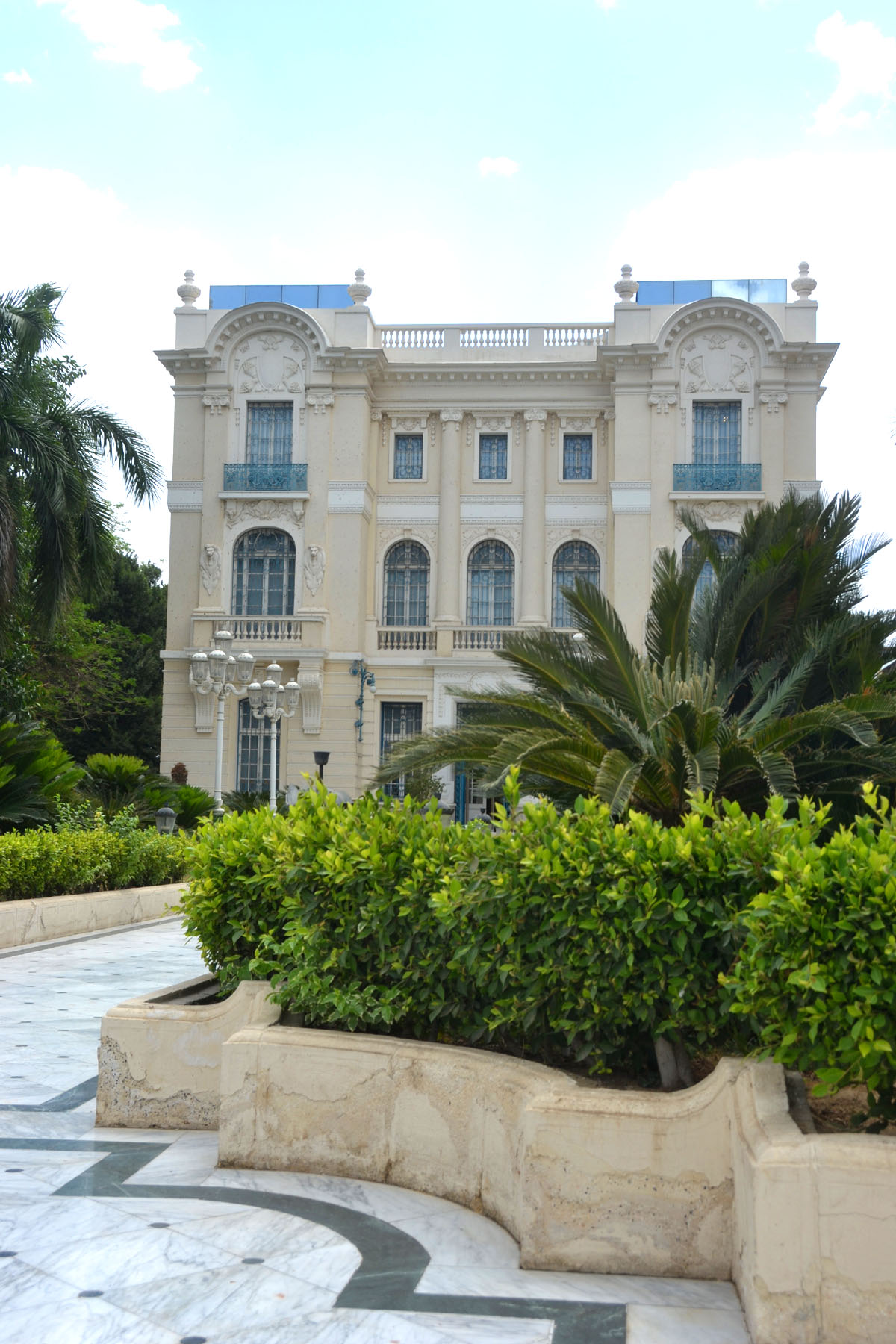

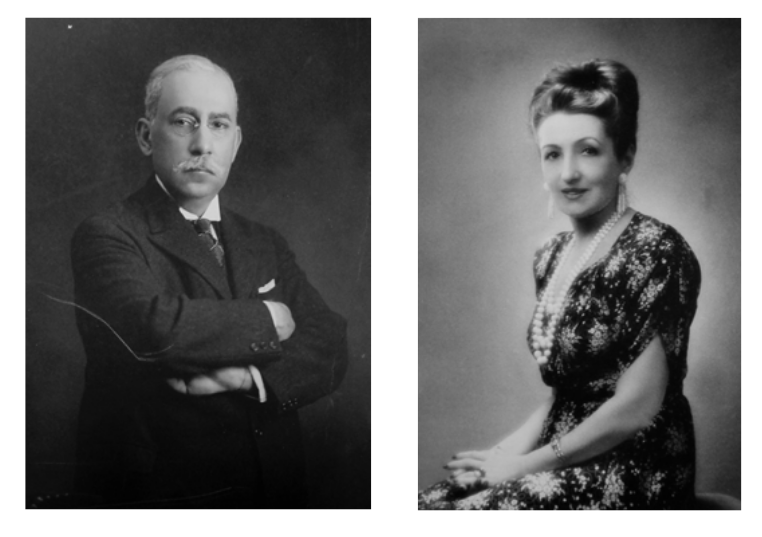

The Khalil Museum is a touching labor of love by an Egyptian politician and his French wife, brought together by their shared love of art.
The museum contains a massive collection of Impressionists gathered by the couple over the years and amassed inside their Nile-side palace.
Mahmoud Khalil and his wife purchased the neo-Classical palace in 1915 for their family residence.
But they never dreamed it would someday become a destination for art lovers.
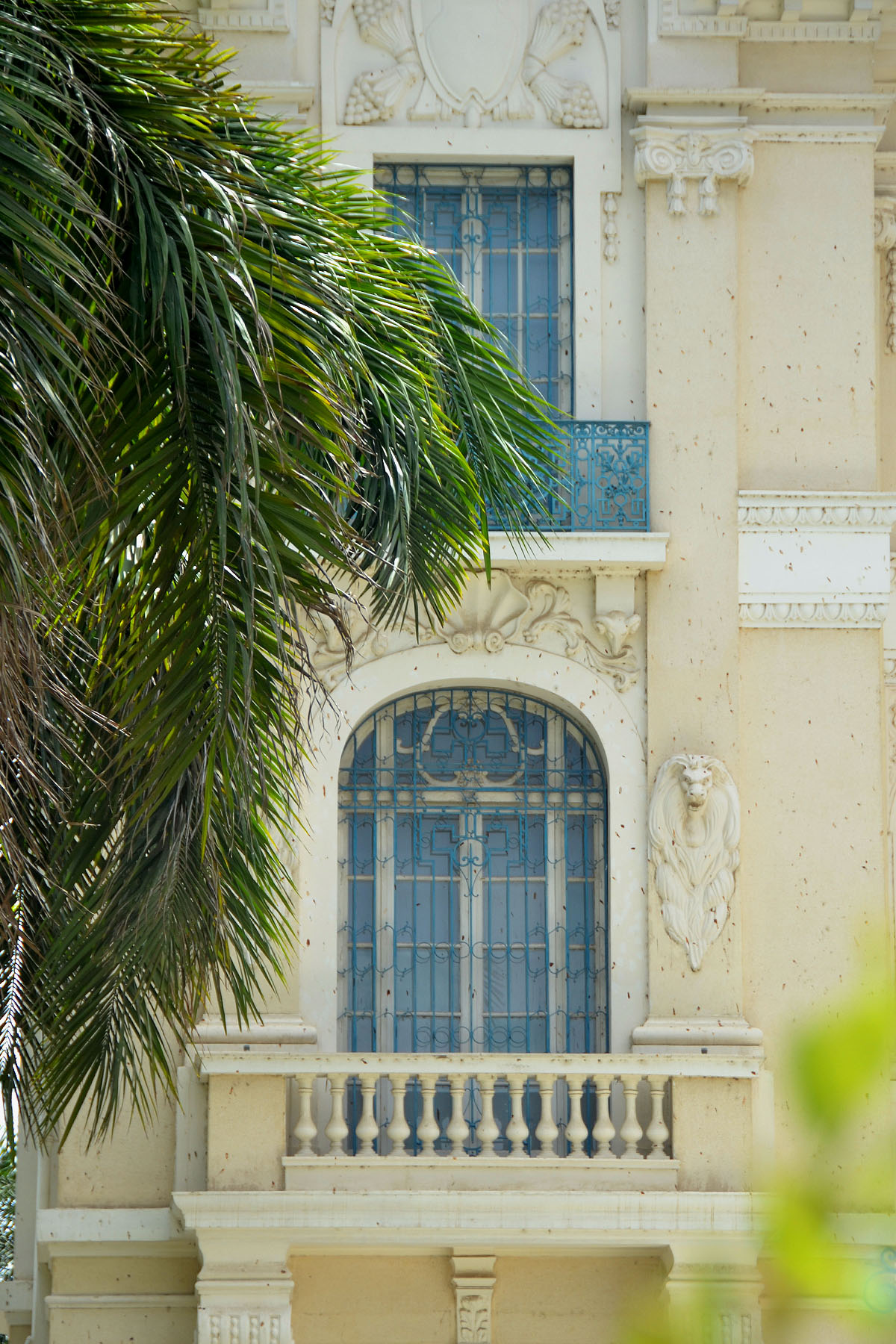

Born in Cairo in 1877, Khalil studied law at the Sorbonne in Paris. There he met Emilienne Luce, a French music teacher and theater performer. She instilled her love of collecting art into Khalil.
The couple married and settled down in the Cairo palace that would soon fill with their art collection.
Khalil was a life-long politician who served twice as Egypt’s prime minister. He also worked tirelessly to strengthen cultural ties between Paris and Cairo.
Encouraged by his wife, Khalil spent years amassing his collection of priceless Impressionist paintings and objects d’art.
Before his death in 1953, Khalil left the palace and its enormous collection to his wife. She then left it to the Egyptian government to be turned into a museum.
Today the museum is a testament to the couple’s life-long passion for the arts.
The missing Van Gogh
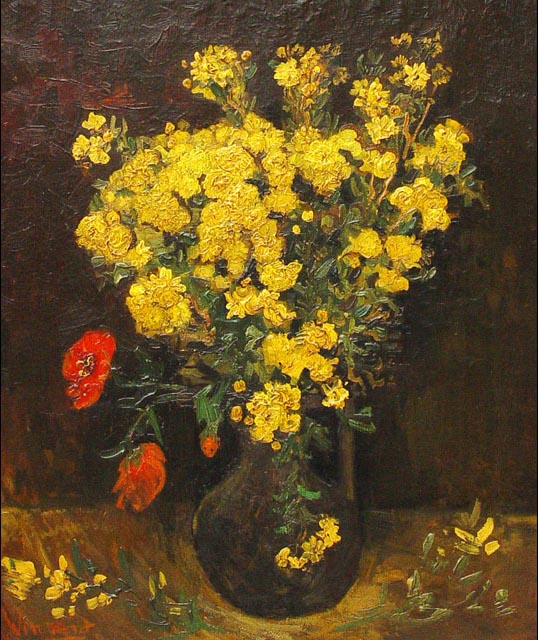

The museum was mostly visited by arts lovers in-the-know and remained off the beaten tourist path for years.
But it gained international attention in 2010 when Van Gogh’s Poppy Flowers (1887, above) was cut from its frame and stolen from the museum.
Egypt declared a state of emergency in all of its airports and several high-ranking officials faced criminal charges for allowing the theft to occur.
But the painting – finished just a few years before Van Gogh’s death – was never recovered.
What’s even more strange is the fact Poppy Flowers had been stolen from the Khalil Museum once before – in 1978.
After that theft, the painting was recovered a decade later in Kuwait. It was then returned to the museum under shady circumstances that left some art critics speculating that the recovered painting was actually a fake.
After that string of scandalous thefts, the museum closed for a decade and underwent extensive renovations (including a new security system).
It finally opened again to the public in 2021.
Though the guide books and tourist crowds haven’t caught up yet. Which means it’s the perfect time to visit.
Inside the Khalil Museum
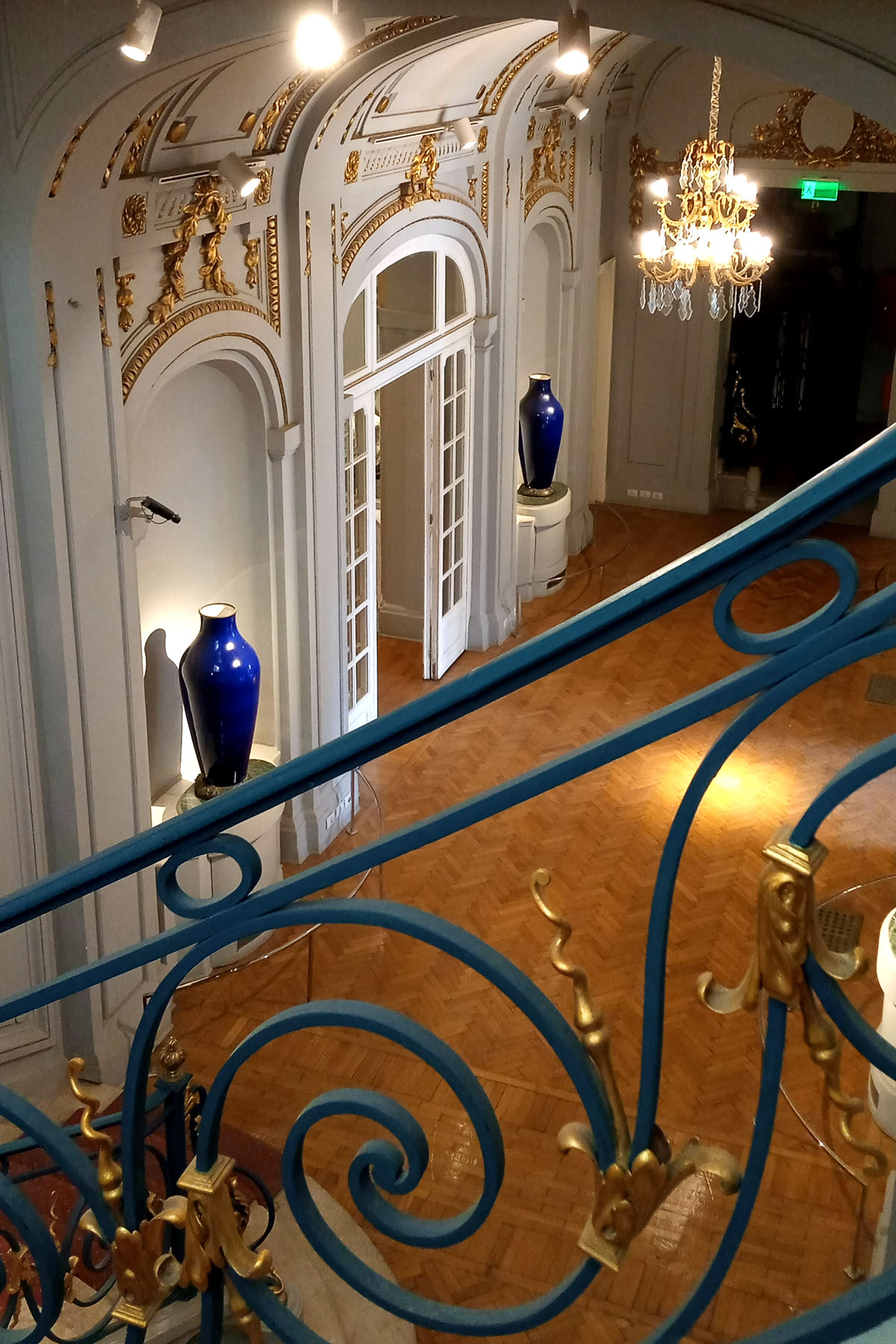

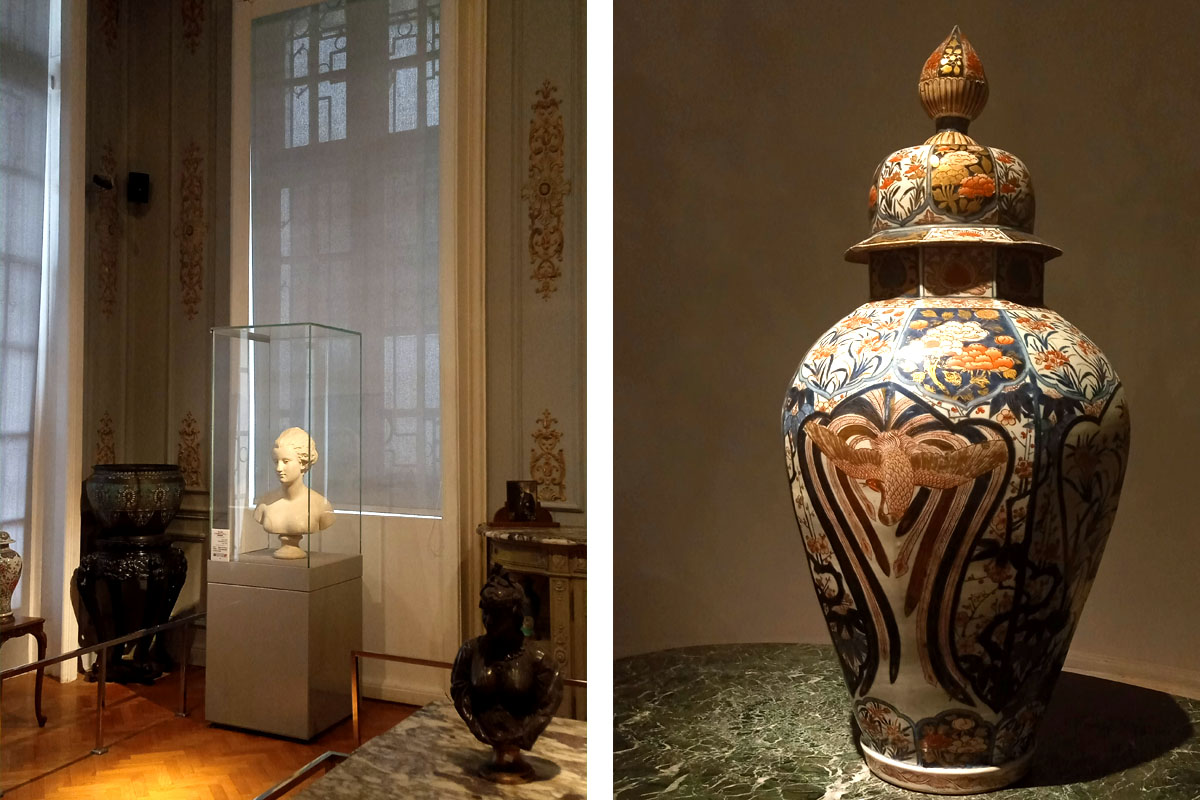

A long walkway lined with rubber trees and Cuban royal palms leads to the museum’s striking Art Nouveau facade.
Inside, the security is almost comically strict. You leave your ID at the desk, and your bags are put away in a locker to be picked up when you leave.
There are no DSLR cameras or video allowed. And this means you can only take photos with your phone camera.
Try and sneak in a TikTok or two (like a pair of friends did when I was there), and you’ll get a loud announcement over the intercom telling you to cut it out. The announcements are loud enough to make you jump.
But eventually they just become amusing – annoying, but not enough to spoil your visit.
Museum highlights
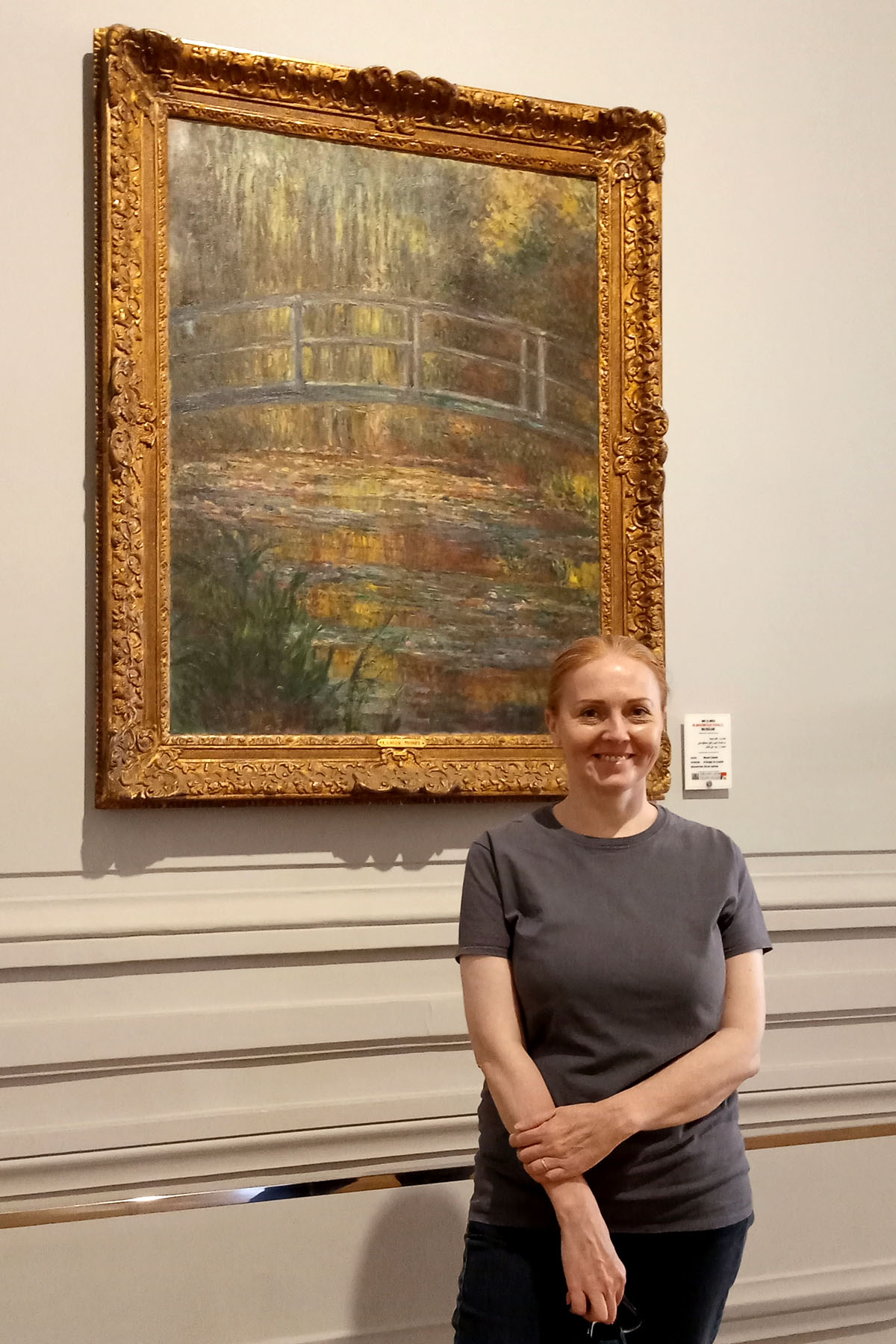

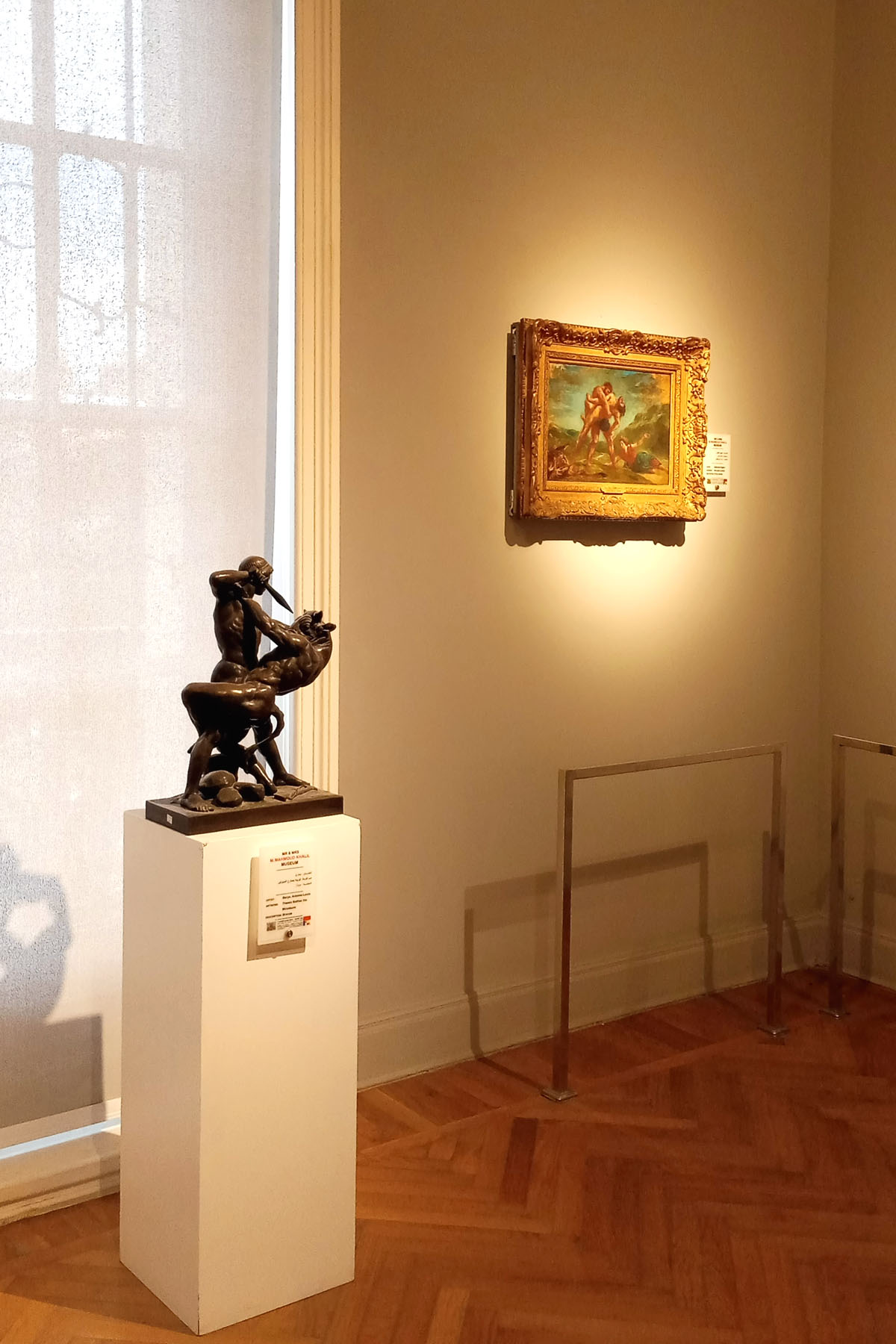

The Khalil Museum boasts more than 300 paintings and 50 sculptures from the 17th to 20th century.
The museum has labels on most paintings that give the artist’s name, painting title and medium. But many other objects (like the vases, textiles and boxes) are not yet labelled.
So where do you begin to explore this vast collection of Impressionist art and sculpture?
Here are the must-see highlights at the Khalil Museum you shouldn’t miss:
1. The Rodin sculptures
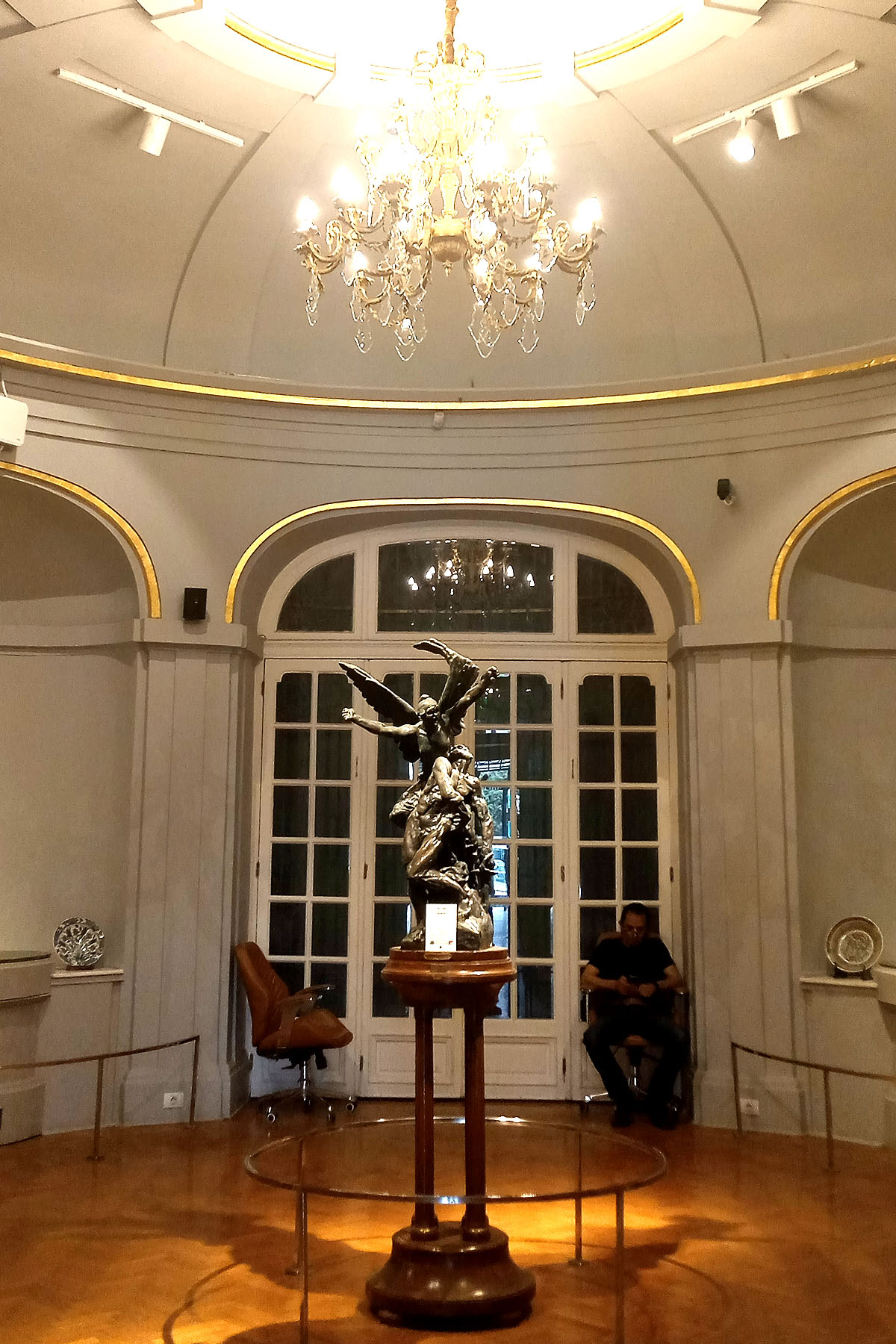

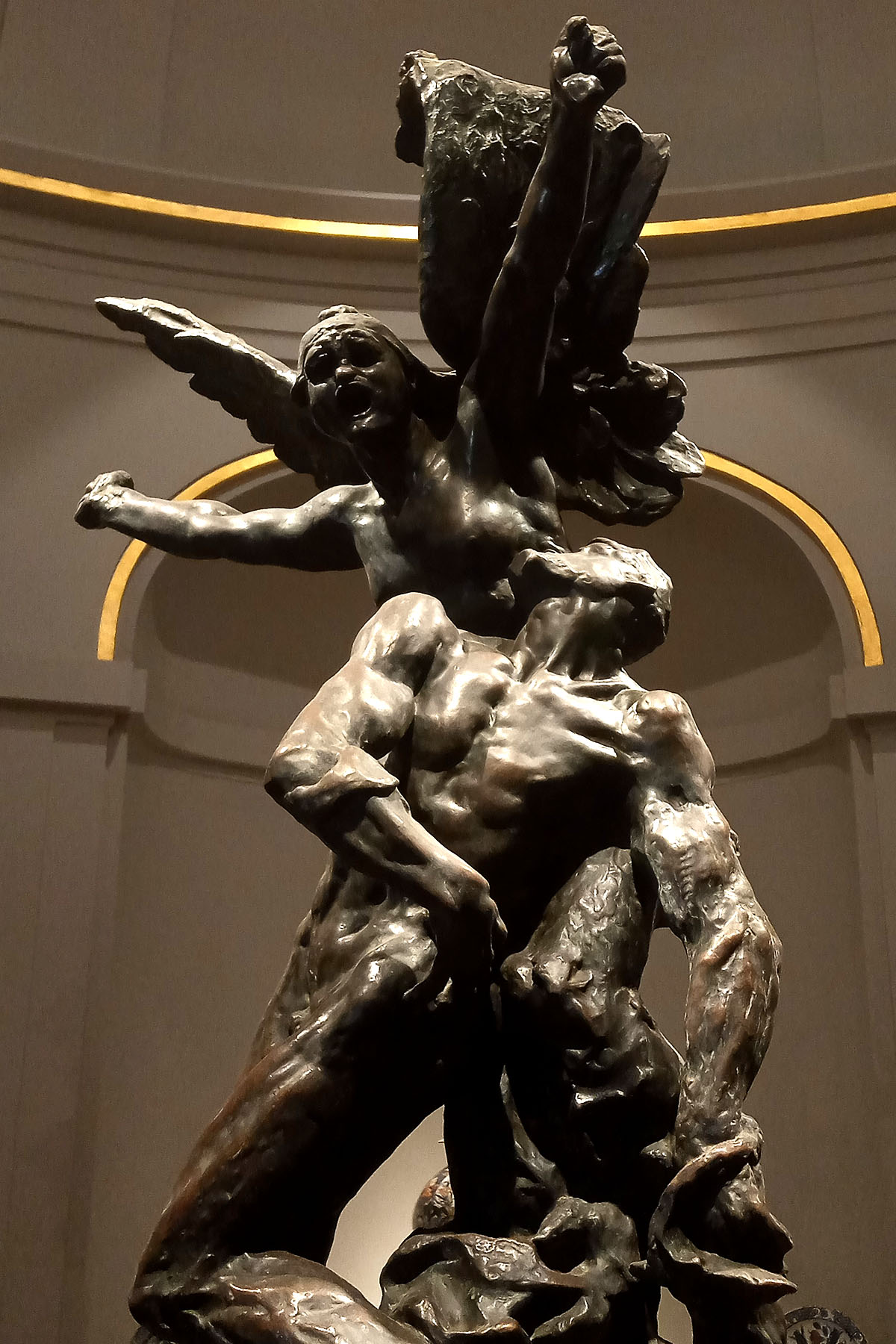

The ground floor has a dramatic Auguste Rodin (1840-1917) statue titled The Call To Arms (above) displayed under a glistening chandelier. The statue is surrounded by some unlabeled vases, Ottoman-era plates and a Belgian wall hanging.
The magnificent sculpture shows a dying French soldier leaning against a winged angel for support.
The sculpture commemorates the courage of Parisian fighters during the Franco-Prussian War while defending their city against the Germans.
There’s also a plaster sculpture of French novelist Balzac, done in rougher lines that portray the bulky realist writer.
The stout body is sculpted with the same kind of honesty that Balzac used in his novels.
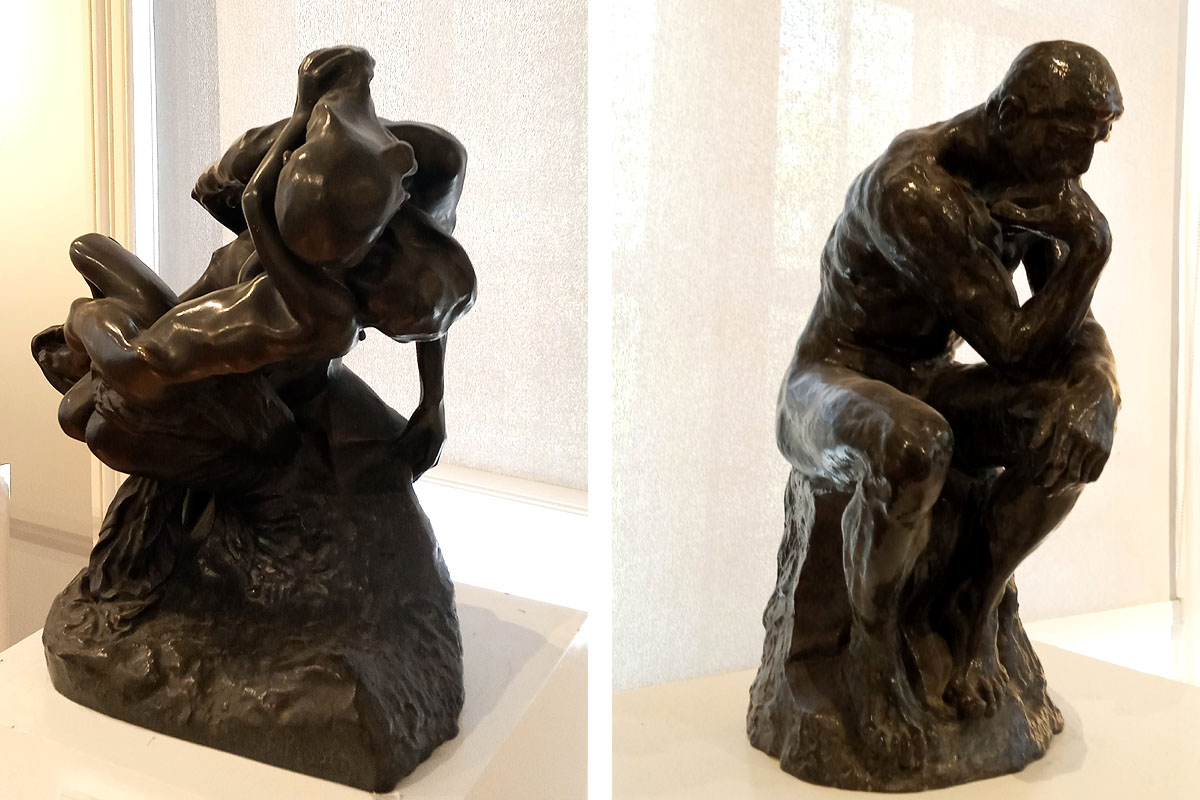

The museum’s collection also includes bronze casts of beloved Rodin sculptures like The Thinker (above). This iconic sculpture symbolizes philosophy – and used a muscular French prizefighter as the model.
There’s also a bronze cast of the Bust of Victor Hugo, which the French novelist sat for in short half-hour sessions.
Rodin completed his studies from the porch of Huge’s Parisian home. There, the sculptor looked up at Hugo through the window to complete his sketches.
And don’t miss the masterful Youth Triumphant (above), a bronze cast that depicts a young woman resting in the arms of an elderly woman and kissing. The older woman is thought to symbolize Fate, while youth is seen overcoming age.
2. The Corot landscapes
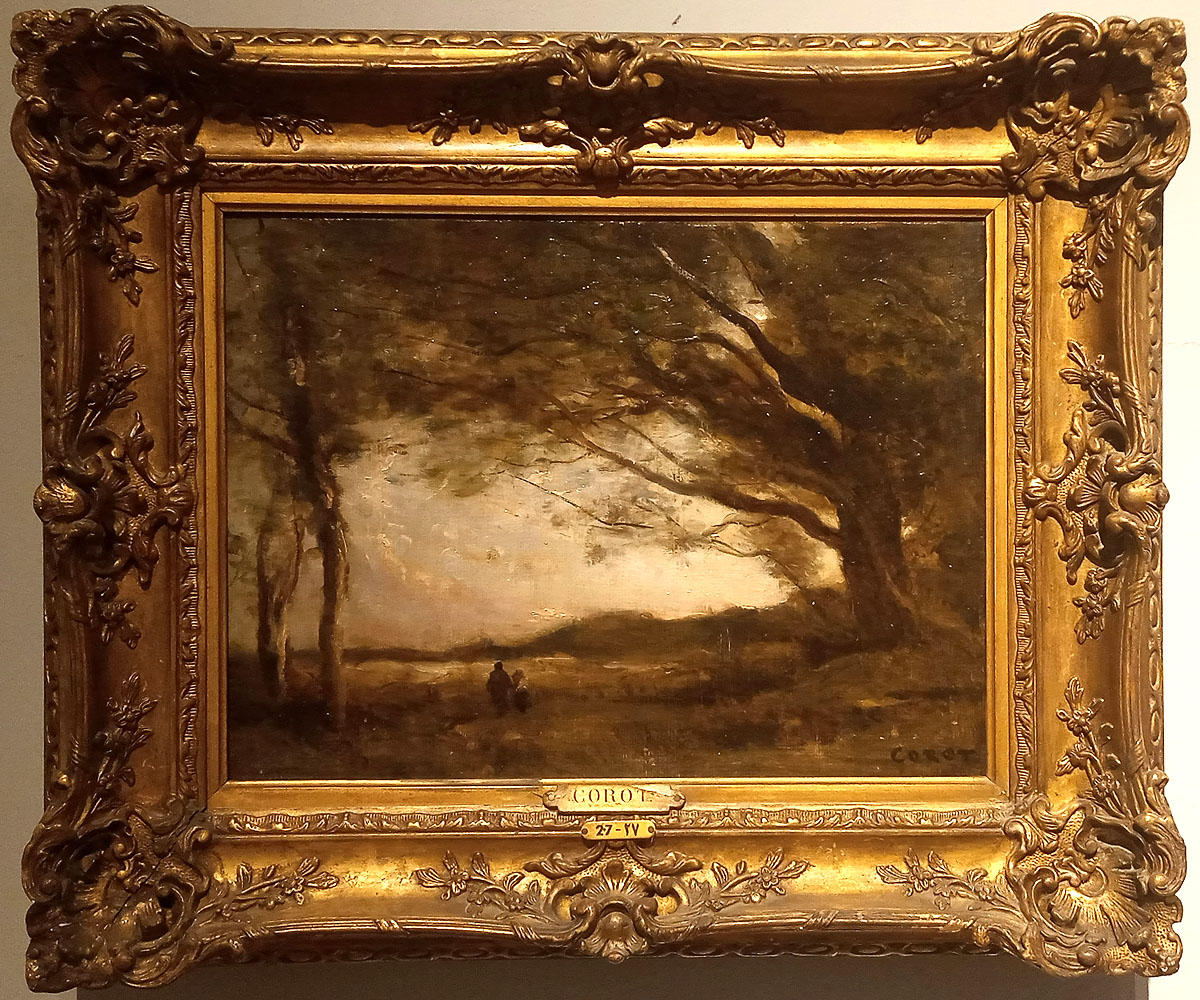

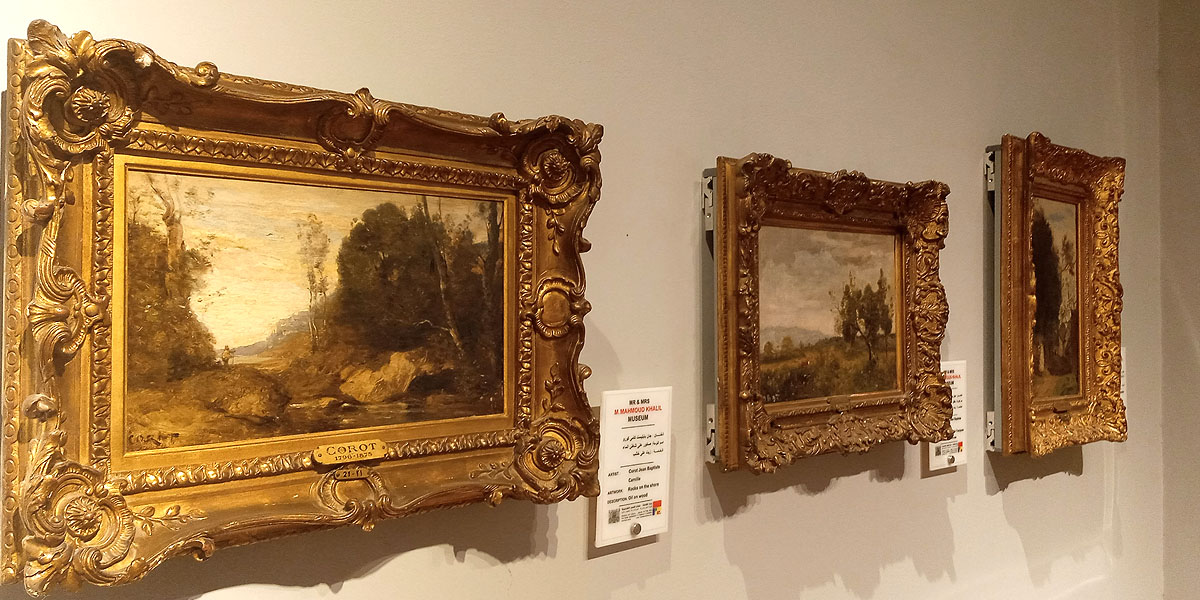

The museum’s collection of Corot landscapes set the stage for the looser brush work of the Impressionists.
Jean-Baptiste-Camille Corot (1796-1875) was a prolific artist of the Neo-Classical tradition whose latter landscapes influenced the plein-air (outdoor) style of Impressionism.
Corot’s landscapes at the Khalil Museum depict windswept trees, stormy skies, moonlit water and dramatic cliffs that showcase his moody style and use of natural light.
Corot studied painting for years but was slow to gain public recognition. Eventually artists like Delacroix recognized his talent.
And Corot’s increasingly impressionistic style sealed him a place in French art history.
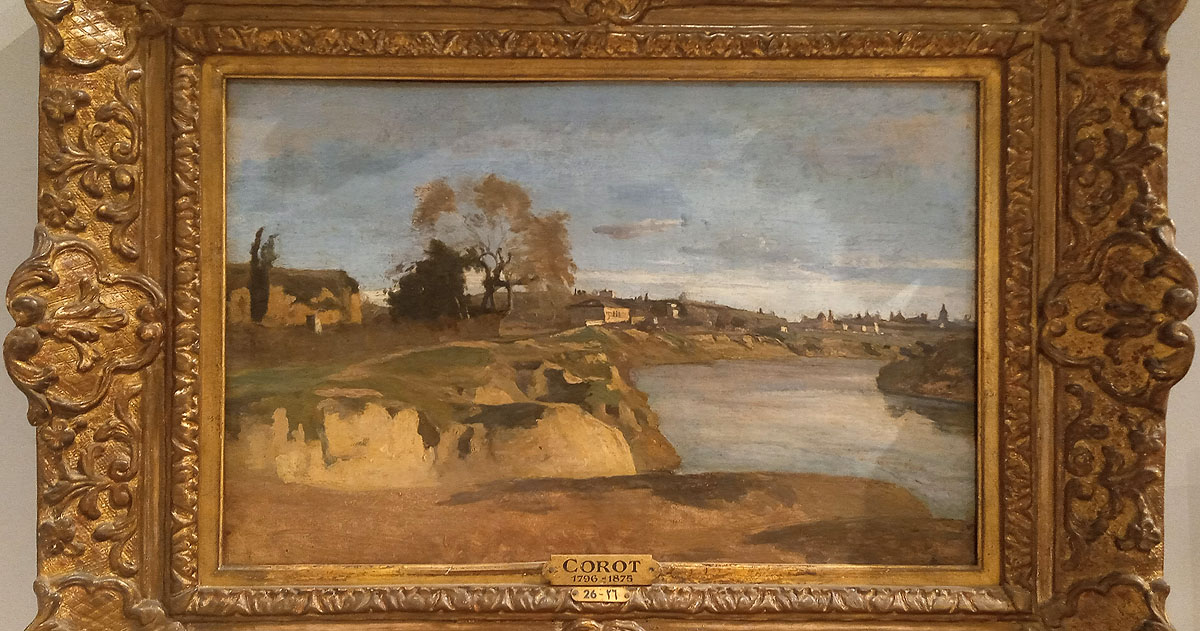

In his latter years, Corot’s landscapes turned dreamier with more fluid strokes and atmospheric lighting.
Corot taught a slew of art students and supported others with a nearly proverbial kindness. He bought a house for Daumier, a painter who’d gone blind, and supported Millet’s widow and children financially.
Corot was a tremendous influence on Impressionists like Sisley and Renoir with his free-flowing brushwork and depiction of natural light.
3. The Orientalist paintings
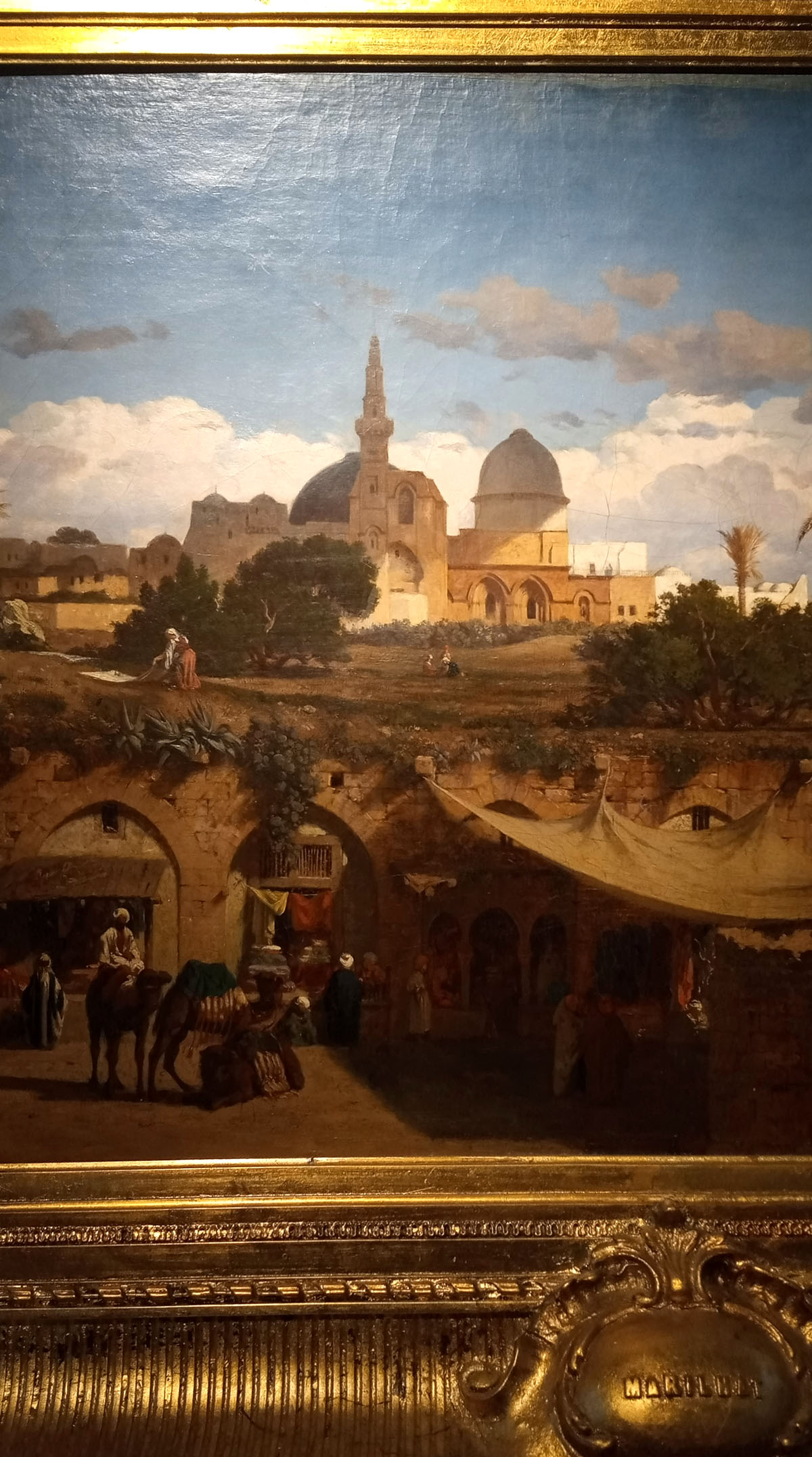

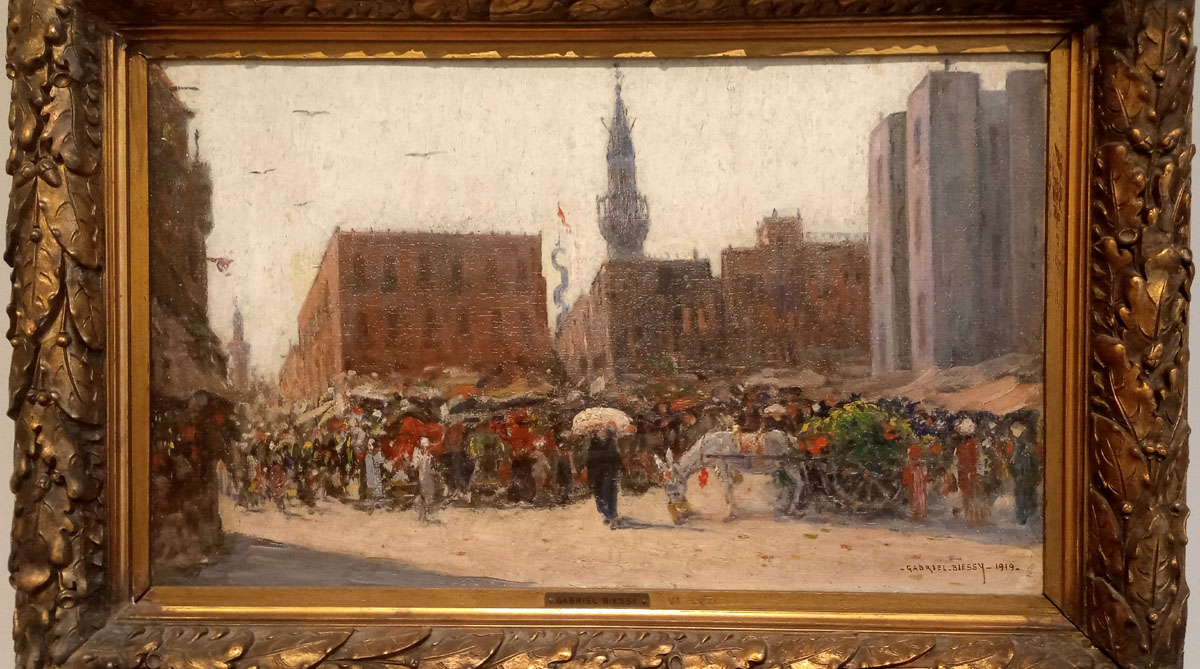

From vibrant street scenes of Old Cairo to serene Nile landscapes, the museum’s collection of Orientalist paintings offers a view of Egypt through rose-colored glasses.
Old Cairo (above, top) by Prosper Marilhat (1811-1847) depicts a covered market in the foreground with far-away domes, palms and a minaret in dramatic light.
Marilhat painted most of his work based on sketches he completed in Egypt in 1831-32. His paintings of Cairo’s monumental mosques and landscapes made French viewers yearn for an Orient they’d never seen.
Cairo’s Streets (1919, above, bottom) by Marie-Gabriel Biessy (1854-1935) portrays a bustling street scene with a towering Ottoman-style minaret and modern apartment buildings. The wagon carrying leafy vegetables can still be seen today in the city’s working-class districts.
Biessy traveled widely across Senegal and Egypt to paint Orientalist landscapes.
He served as the director of Cairo’s college of fine arts towards the end of his career.
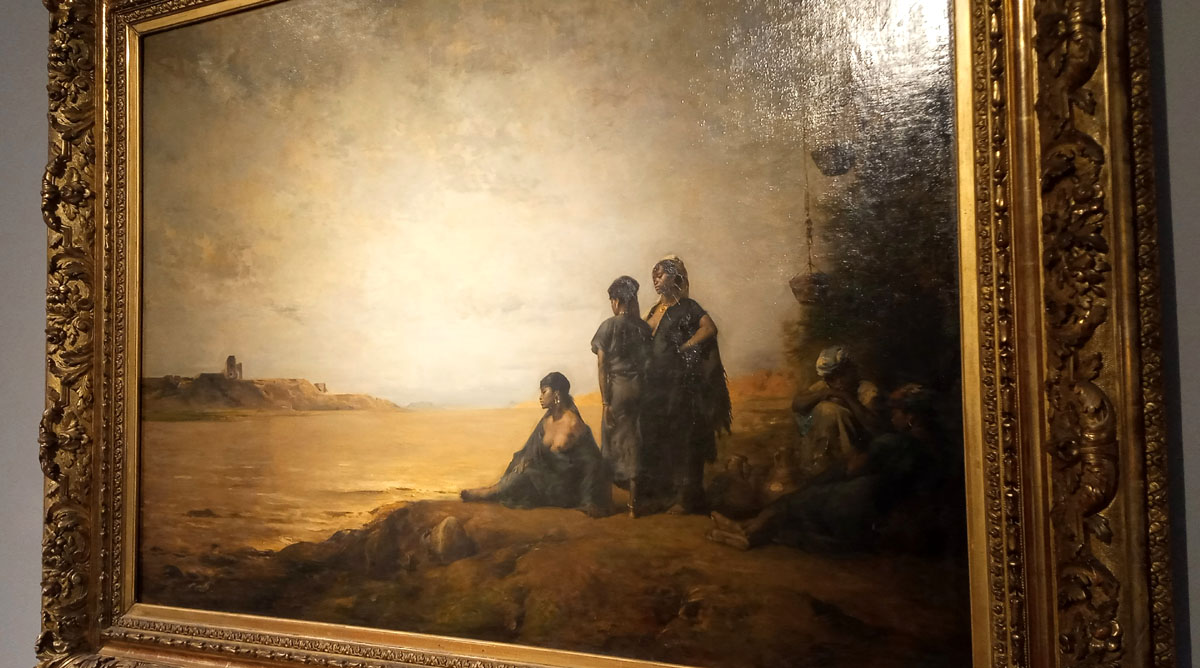

The Nile in Upper Egypt (above) by Eugene Fromentin (1820-1876) likely depicts Nubian women in various states of undress gazing out over the river.
The painting is one of the largest in the Orientalist collection and showcases Fromentin’s signature striking composition.
Fromentin painted several scenes of Egypt. But he’s best known for his studies of Algeria, which he visited extensively and portrayed with an unprecedented accuracy.
4. Monet’s Water Lilies
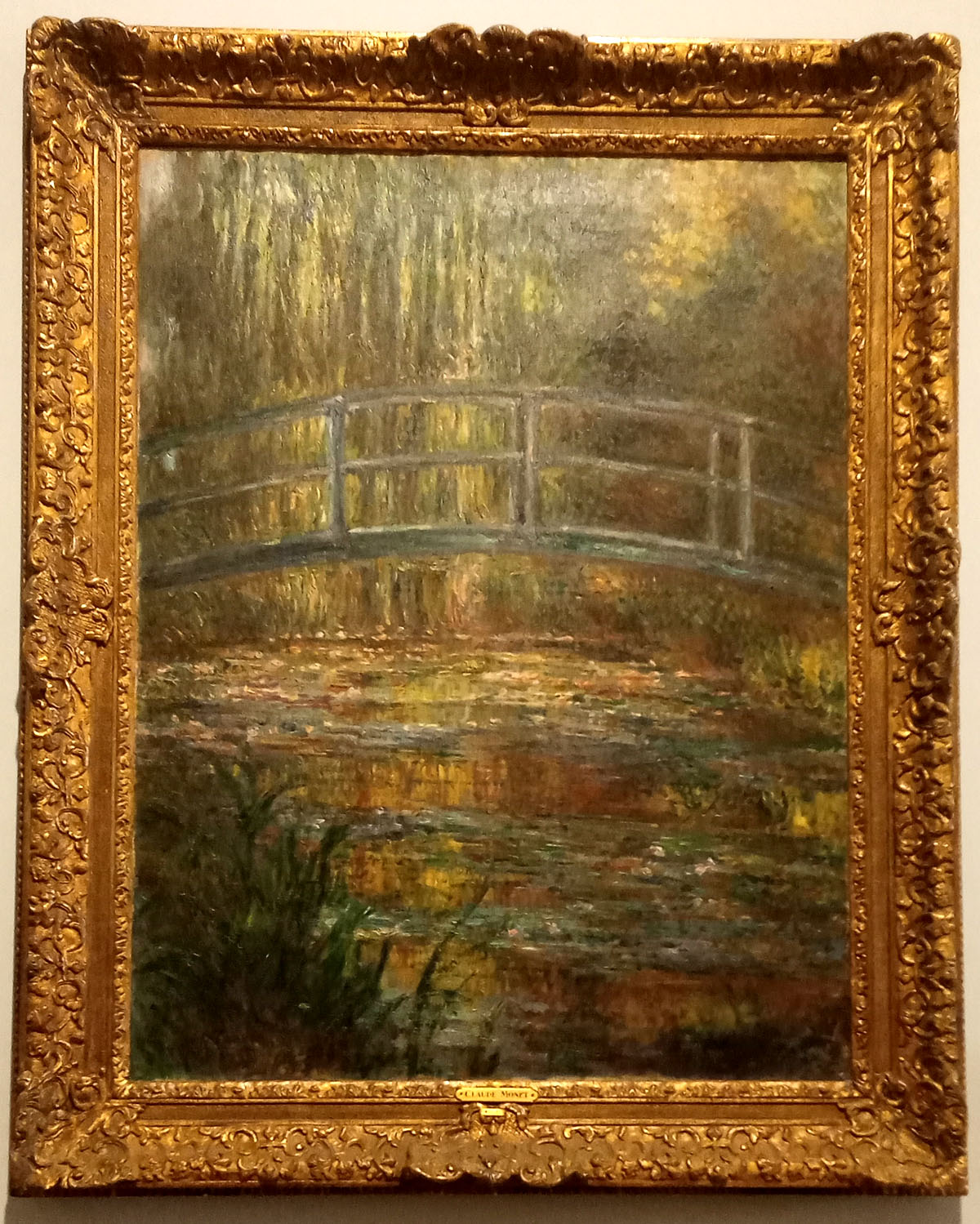

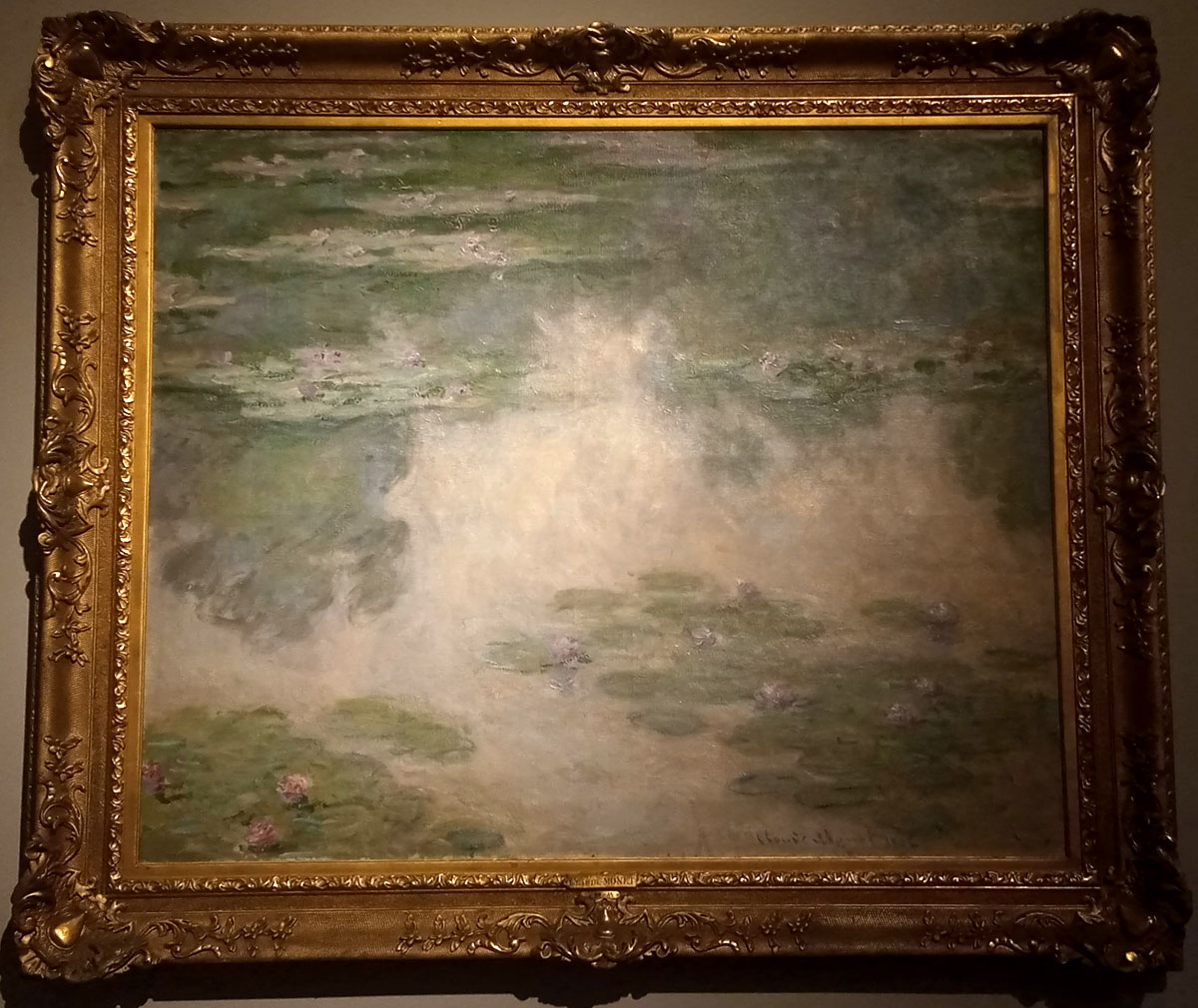

The museum has a stunning collection of Monets including paintings from his famous Water Lilies series.
Claude Monet (1840-1926) painted the iconic series of nearly 300 paintings at his Giverny garden during the last thirty years of his life.
The Khalil Museum has two of them.
The first is Bride over the Water-Lilies (above, top, 1899) depicting the famous curved Japanese footbridge at Giverny over a pond framed by a weeping willow. It’s thick with bold colors that suggest a late summer sunset.
It’s also one of the early paintings in the Water Lilies series, which Monet painted from the late 1890s until his death in 1926.
The second painting is the ethereal Water-Lilies (above, bottom, 1907) done in soft pastels and well-blended strokes. The painting is nearly abstract with its emphasis on light and atmosphere over form.
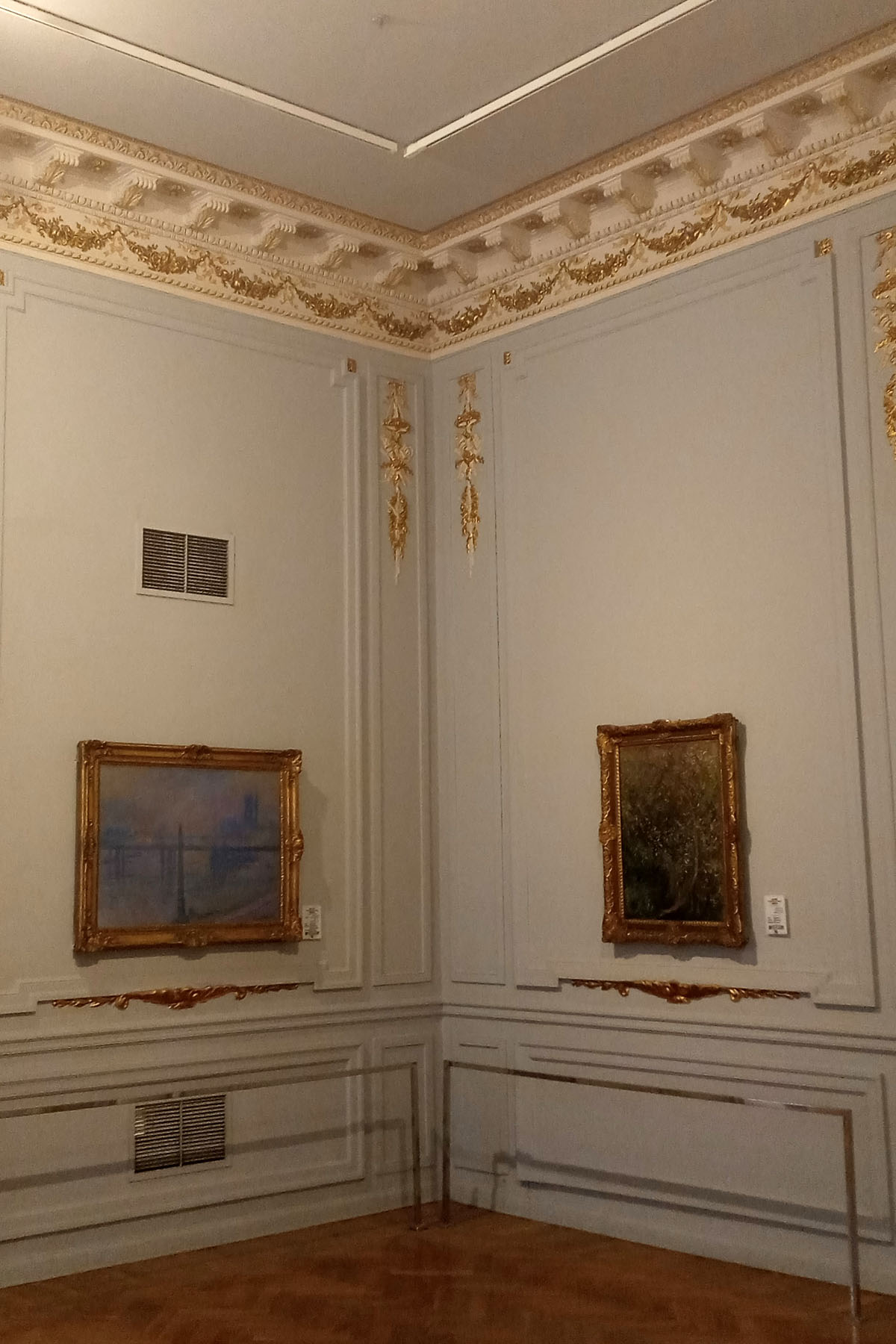

Hugely influential to generations of artists, Monet’s Water Lilies paintings are some of the most recognizable works of 20th-century art.
They opened the door for abstract art and captured the garden under ever-changing conditions.
The last paintings in the series are in startling reds and oranges, done when Monet was diagnosed with a cataract.
Interestingly, Monet imported the water lilies for his garden at Giverny from Egypt and South America.
The museum has a few more gorgeous Monets including a dreamy L’Aiguille de Cléopâtre et Charing Cross Bridge (above, left, 1900) overlooking the water, and Argenteuil, bateaux au long de la berge depicting a row of sailboats along a rustic river bank.
5. The Gauguins
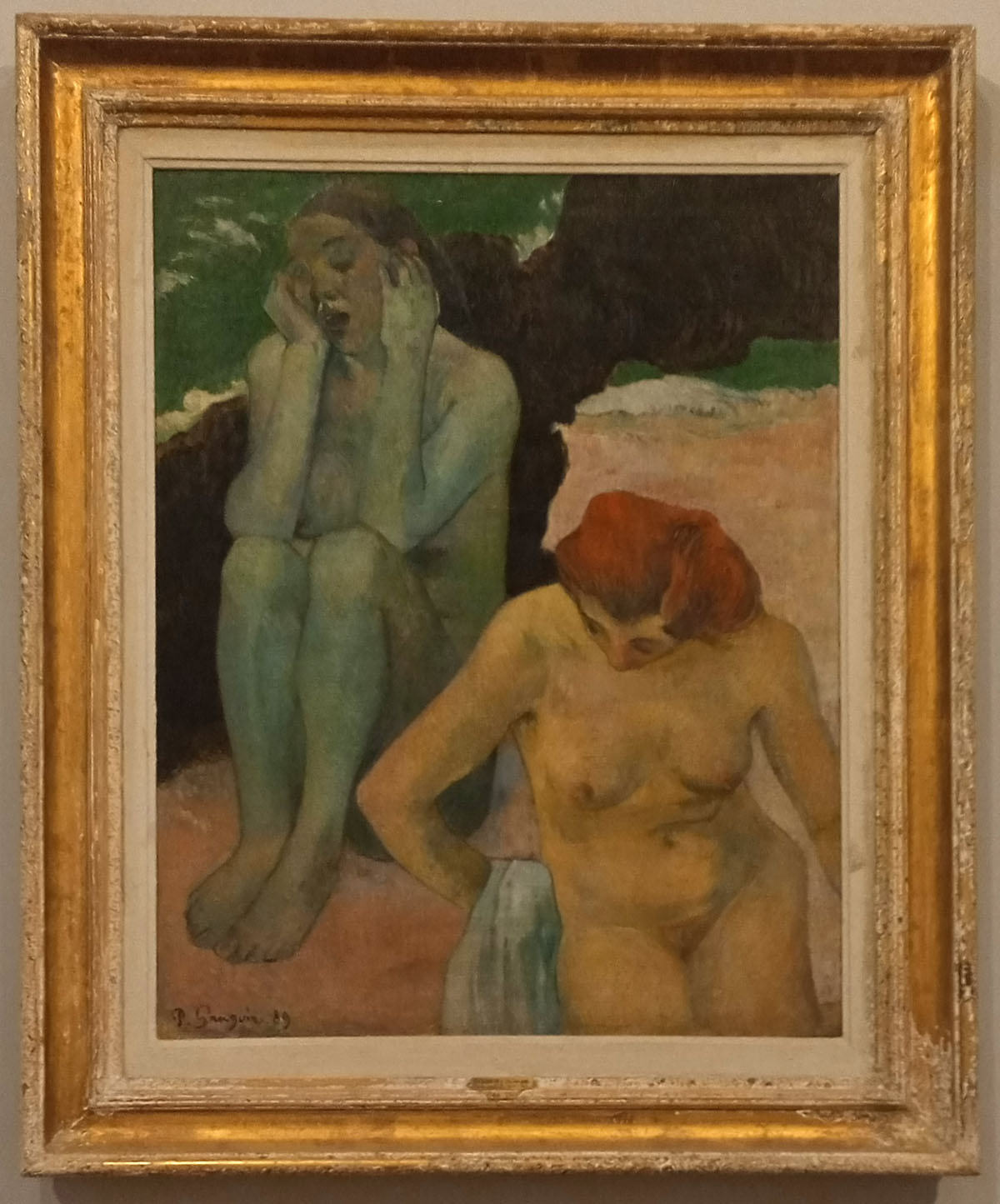

The museum has some striking Gauguins that depict exotic landscapes in the artist’s trademark luscious colors.
Paul Gauguin (1848-1903) is a post-Impressionist artist known for his bold colors and depictions of French Polynesia, where he lived for ten years (and had notorious sexual relations with teenage girls).
The museum’s works showcase Gauguin’s use of Symbolism and color.
Life and Death (above, 1889) is a work of contrasts.
The sensual and fleshy figure of a red-haired woman takes up half the canvas. Her figure is contrasted with the darker and despairing body of a black-haired woman, sitting enclosed by jagged cliffs and a stormy sea.
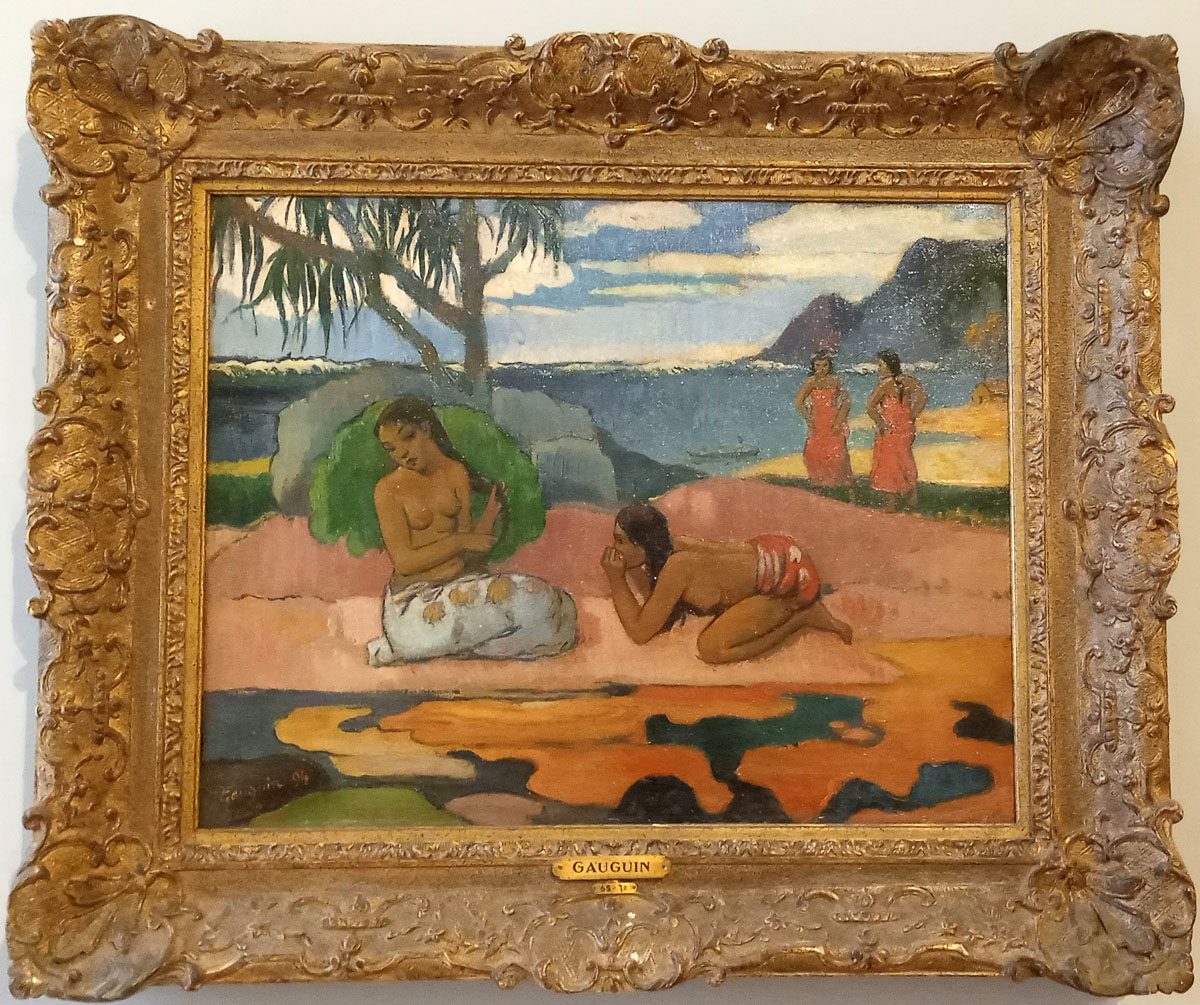

Scène à la Dominique (above, Scene in Dominica) shows a scene of everyday Polynesian life that’s so often featured in Gauguin’s work.
The painting features two women in the forefront lounging on pink sand beside orange-speckled water.
Gauguin is a proverbial figure who lived for his art. He left behind his wife and children in Copenhagen to live in Tahiti and paint.
6. The Sisley landscapes
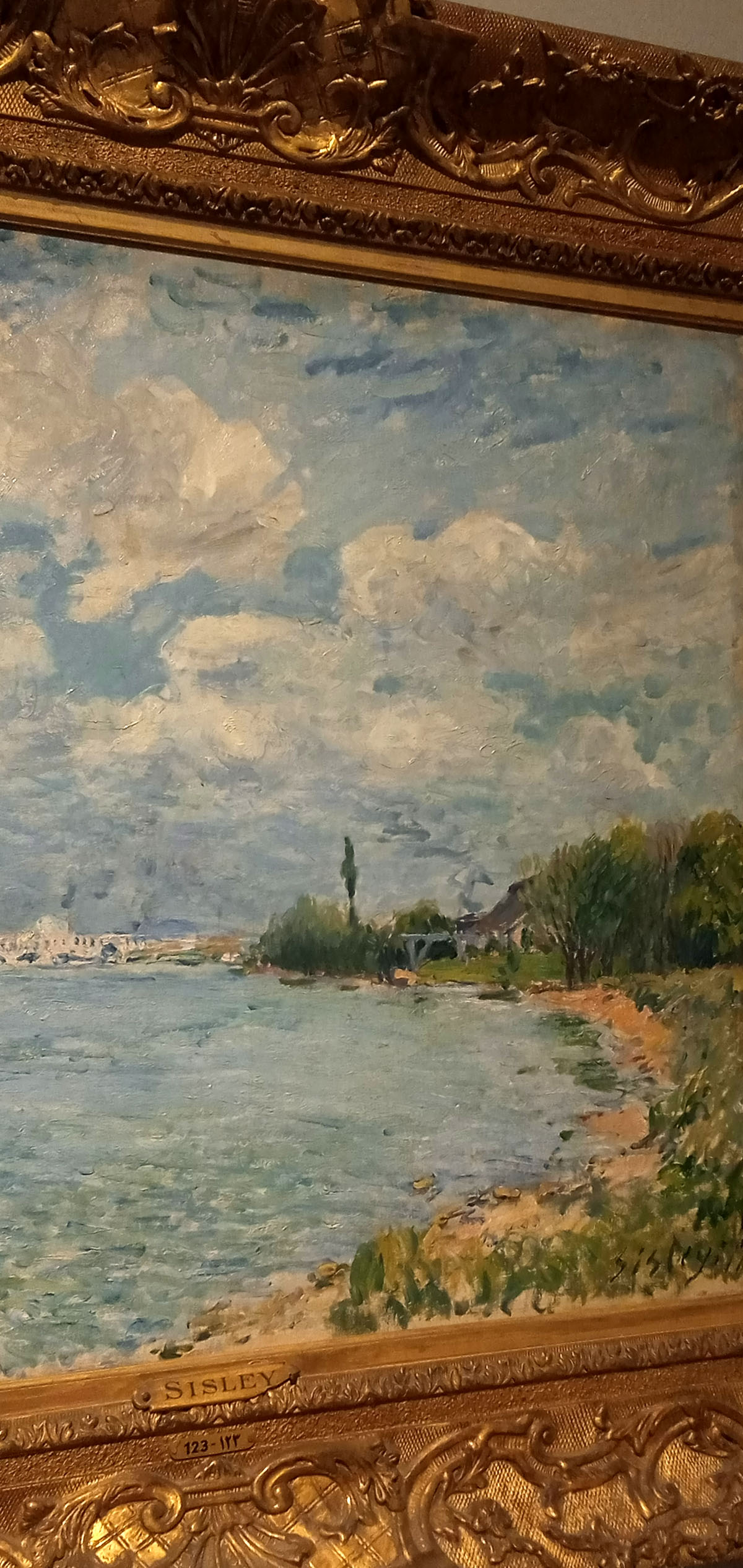

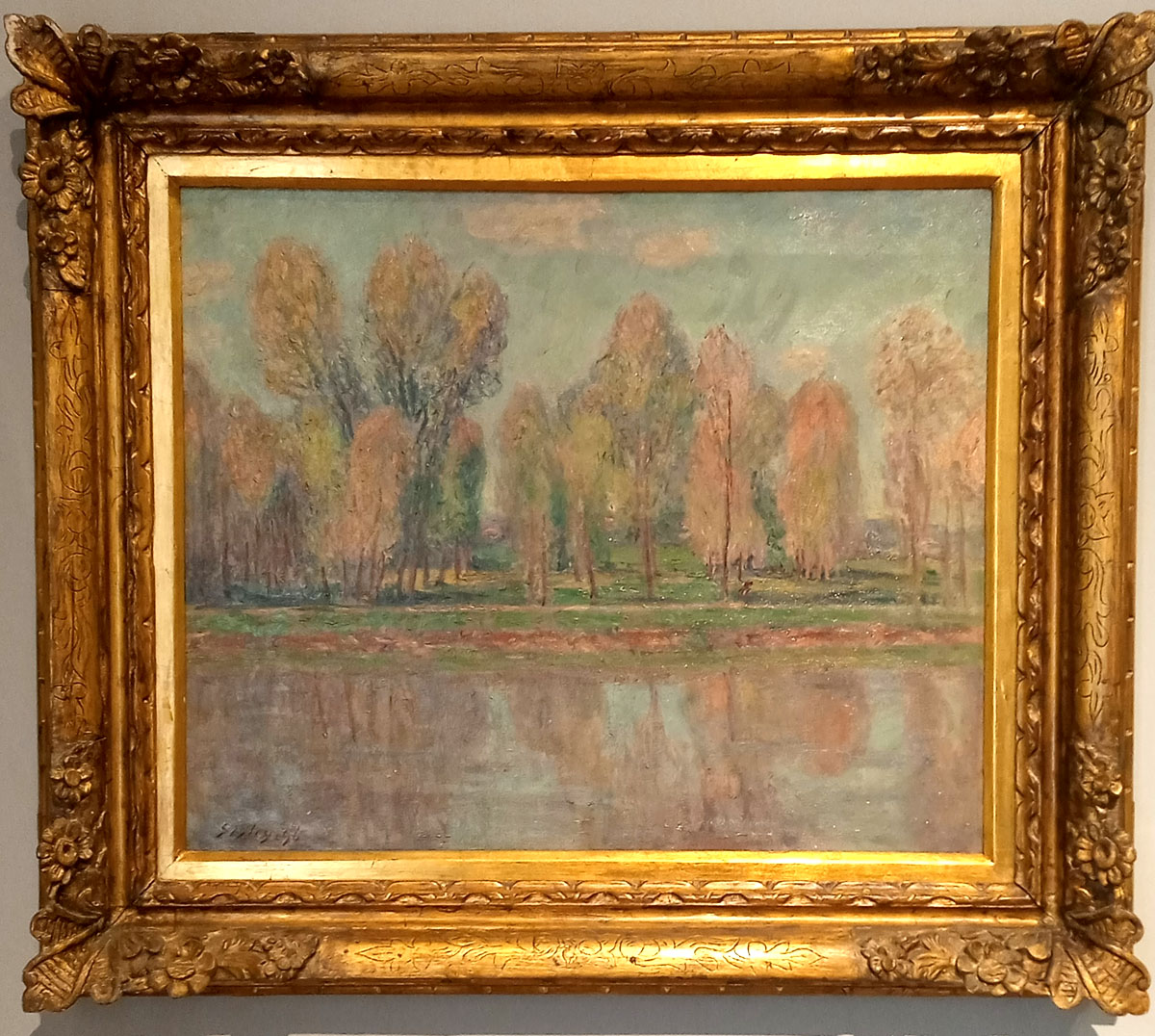

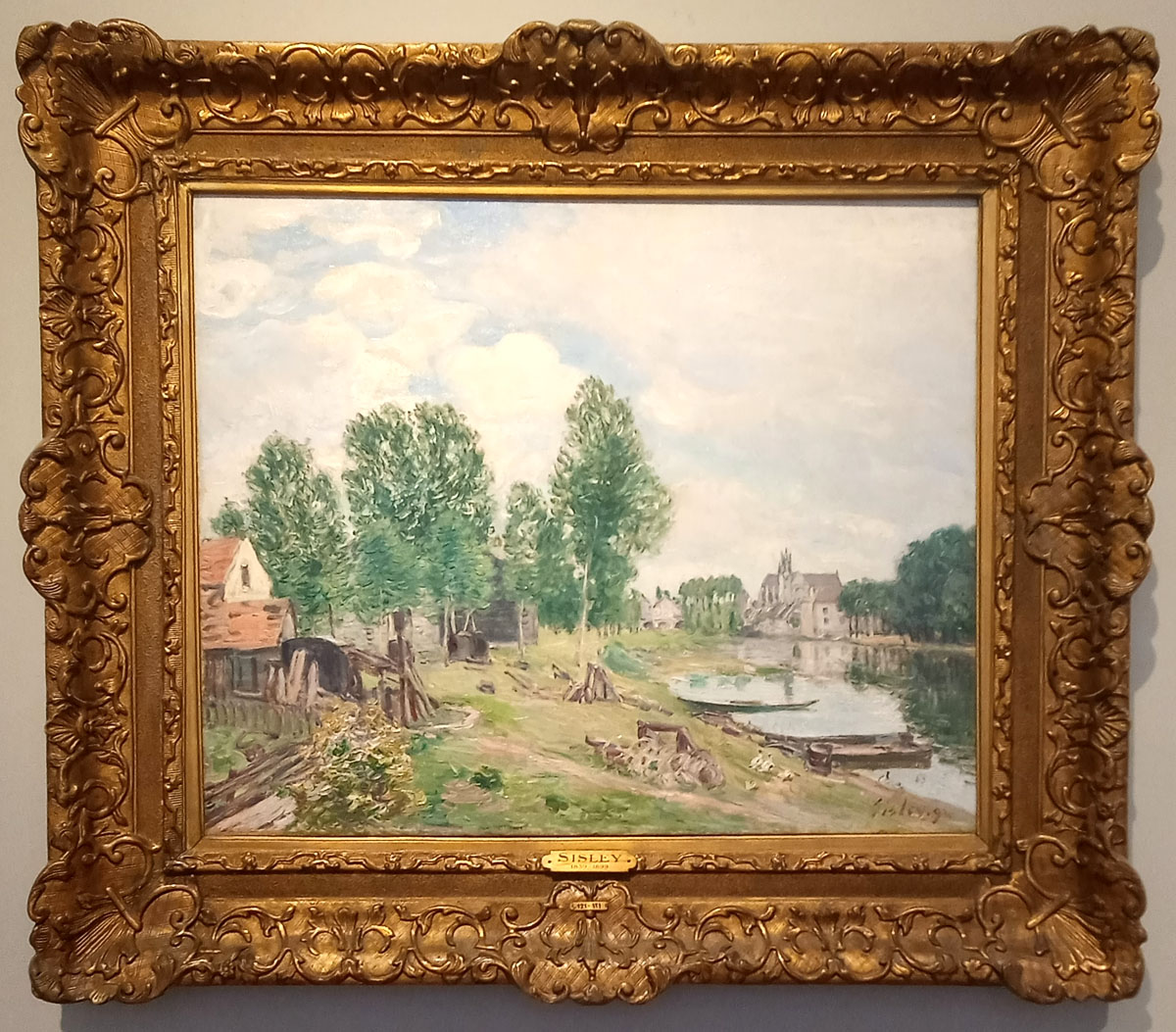

The museum’s collection of Sisley landscapes showcase the Impressionist painter’s tranquil and expressive style.
Alfred Sisley (1839-1899) was a prolific Impressionist who often painted plein air (outdoors, instead of in a studio). His best-known landscapes portray scenes of the River Thames and landscapes at Moret-sur-Loing.
A British national who spent most of his life in France, Sisley is known for his soft, pastel palette and gently atmospheric landscapes.
Seine at Sunrise (above, top) is a textbook Impressionist landscape with its thick brush strokes, milky skies and softly-blended grass. It’s a free-flowing effort to capture the ever-changing light.
Moret in Autumn (above, middle) features a row of tall, pastel trees reflected hazily in the water.
Wood Storehouse (above, bottom) is a soft landscape in minimal tones depicting cloudy skies, windblown trees and rural serenity.
7. The Millet drawings
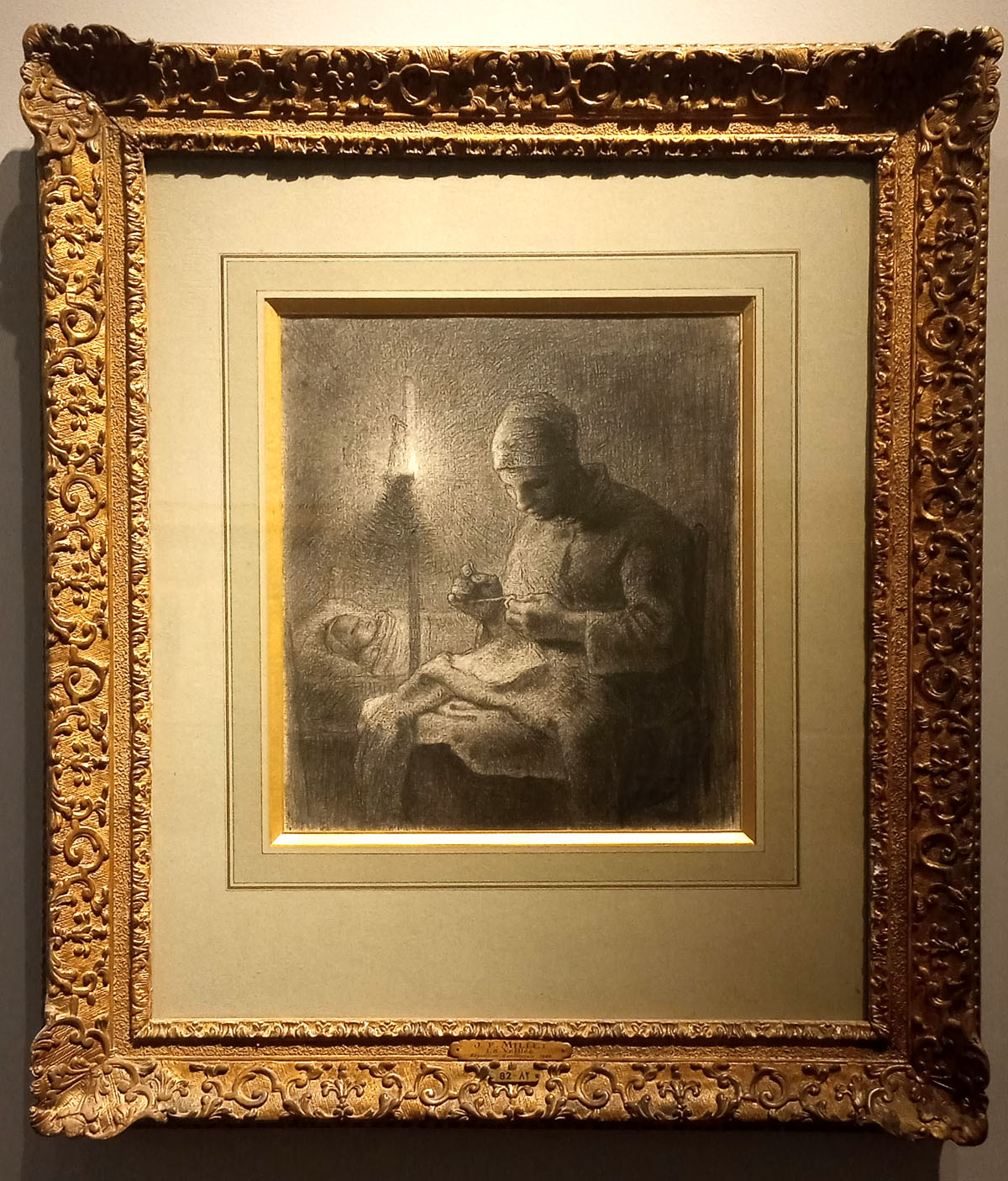

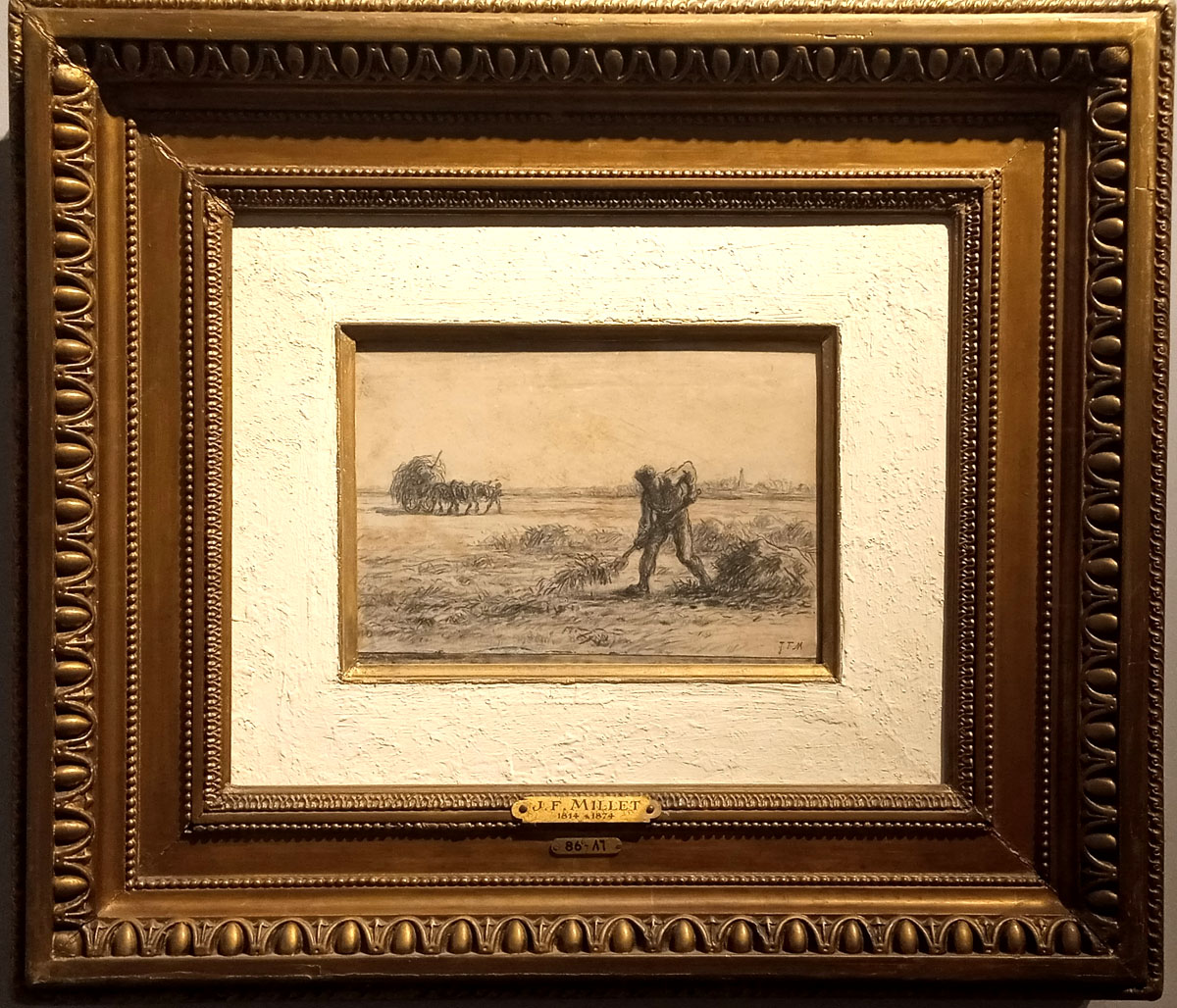

The Khalil Museum’s Millet drawings illustrate his revolutionary depictions of ordinary farmers and everyday life.
Jean-Francois Millet (1814-1875) is best-known for his oil paintings. But he’s also a notable artist for his pastels, drawings and etchings.
Born to farmers in a Normandy village, Millet takes a more realistic approach to painting. Many of his works feature backbreaking labor and the everyday struggle to survive.
Millet’s depictions of farmers, millers, laundresses and basket makers show the characters as heroic figures. They’re often modeled after Old Master paintings and display superhuman strength and noble character.
Millet’s line work is exquisite. It conjures up entire personalities in a few bold strokes.
Awake (above, top) shows a heartwarming scene of a mother sewing while seeing her baby off to sleep. A light illuminates her muscular hands.
Harvest (above, bottom) is another pencil-on-paper sketch that shows a Herculean figure reaping the bounties of a land on the edge of industrialization.
8. The miniatures
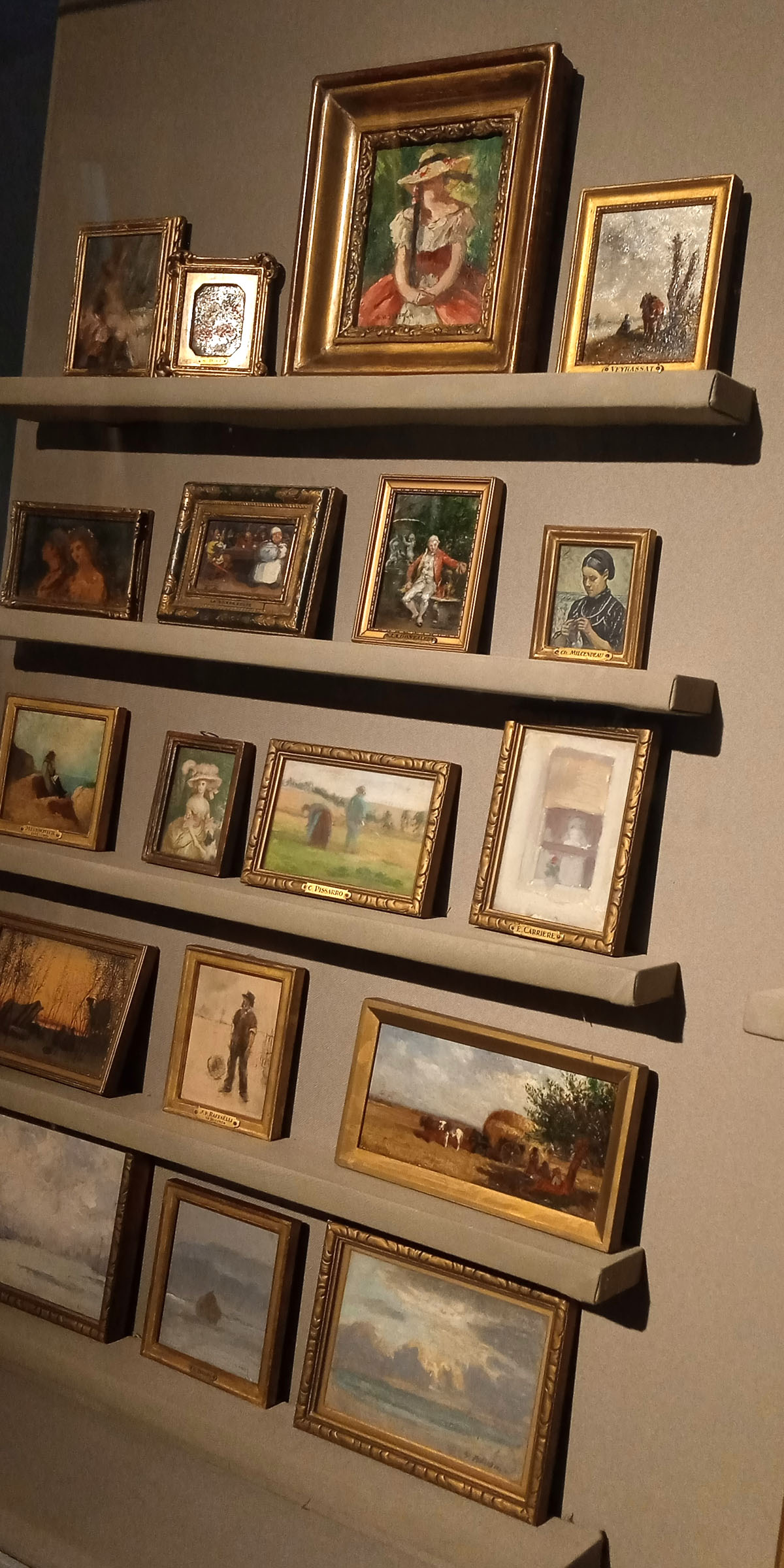

The museum has several dozen miniatures that include portraits and landscapes by top Impressionists and Realists.
The miniatures offer a more personal look at the artistic process. And they give insight into the artist’s journey from sketch and study to painting.
Don’t miss the beautiful Pissarros that depict rural landscapes, the floral by Diaz and the Oriental miniatures.
9. The Degas pastel sketch
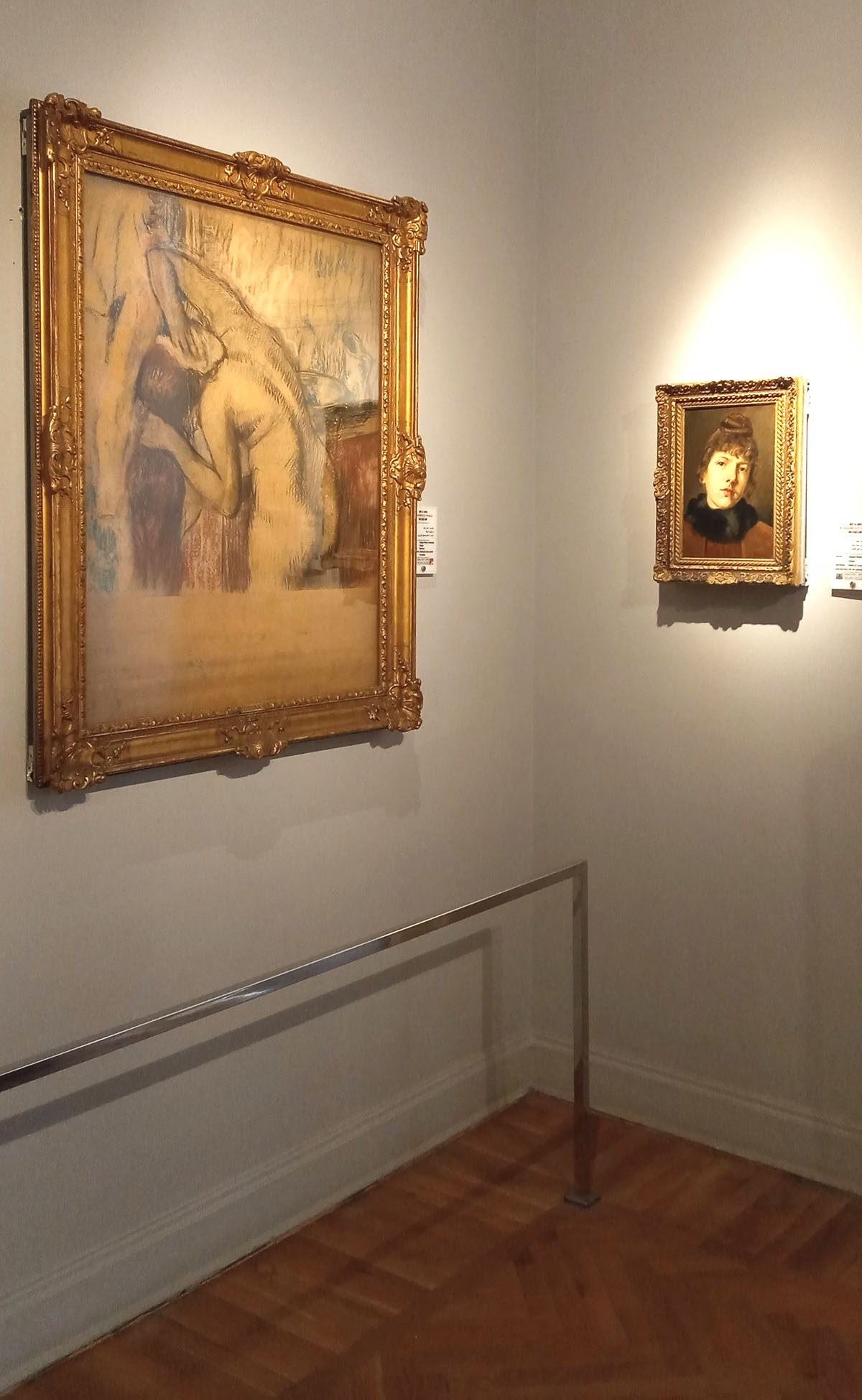

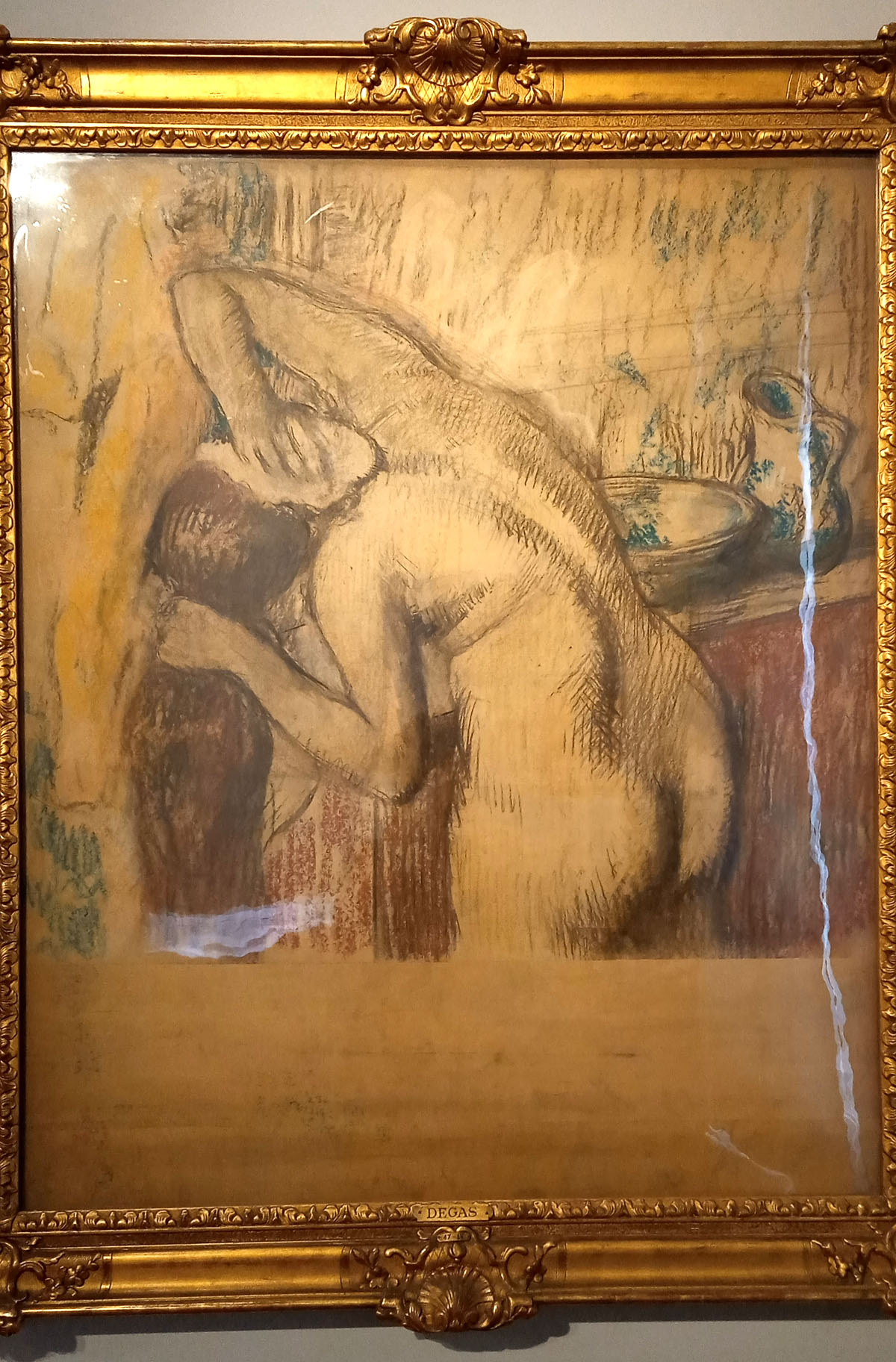

Degas was a masterful draftsman. And this sketch of a nude woman shows his brilliance in capturing movement with a few fluid lines.
After the Bath (inexplicably labelled as Makeup at the museum) shows a long-haired woman drying her hair. Her twisting back is shaded with some beautiful cross-hatch lines.
The sketch (done in charcoal and pastel on paper) is one of Edgar Degas’ (1834-1917) many studies of bathing female nudes.
Degas is also well-known for his depictions of ballet dancers, racehorses and haunting portraits of solitary figures.
But ironically, Degas didn’t consider himself an Impressionist. He saw his art as the result of years of study of the great masters – with no place for spontaneity.
A life-long bachelor, Degas was an isolated figure with an often cruel wit. He enjoyed a years-long friendship with artist Mary Cassatt, but the two had a falling out over Degas’ anti-Semitism.
10. The Pissarro landscapes
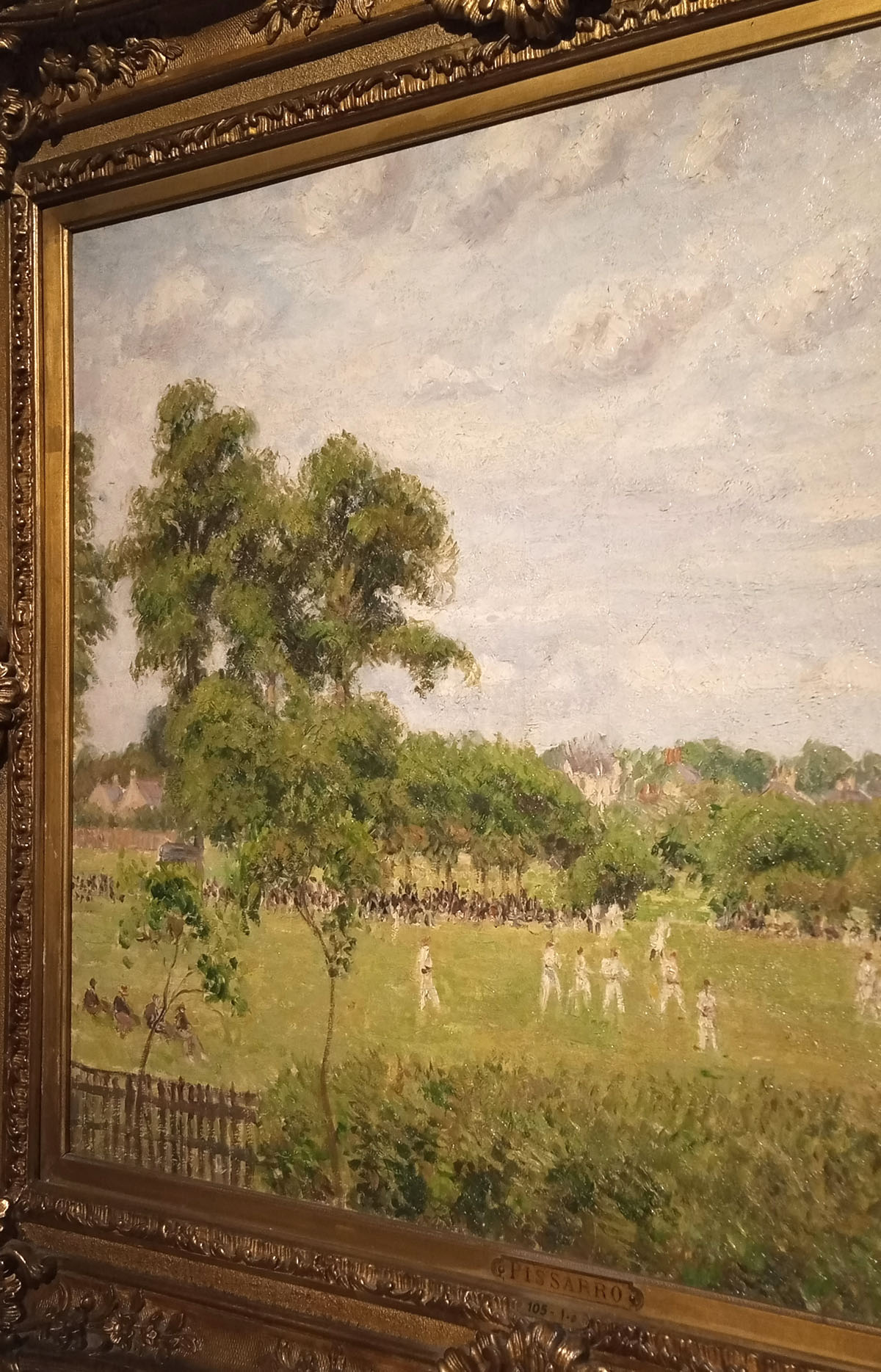

From a glorious summer day in a London park to a moody autumn sunset, the museum’s Pissarro landscapes show the versatility of this Impressionist father figure.
The warmhearted Camille Pissarro (1830-1903) was a mentor for a slew of major Impressionist painters, with his revolutionary brushwork and depictions of ordinary people.
He could have taught the stones to draw correctly, said his artist friend Mary Cassatt.
Pissarro painted natural scenes outdoors (often in one sitting) without beautifying or romanticizing the landscape.
He married his mother’s maid, Julie Vellay, and had seven children with her – six of whom became painters.
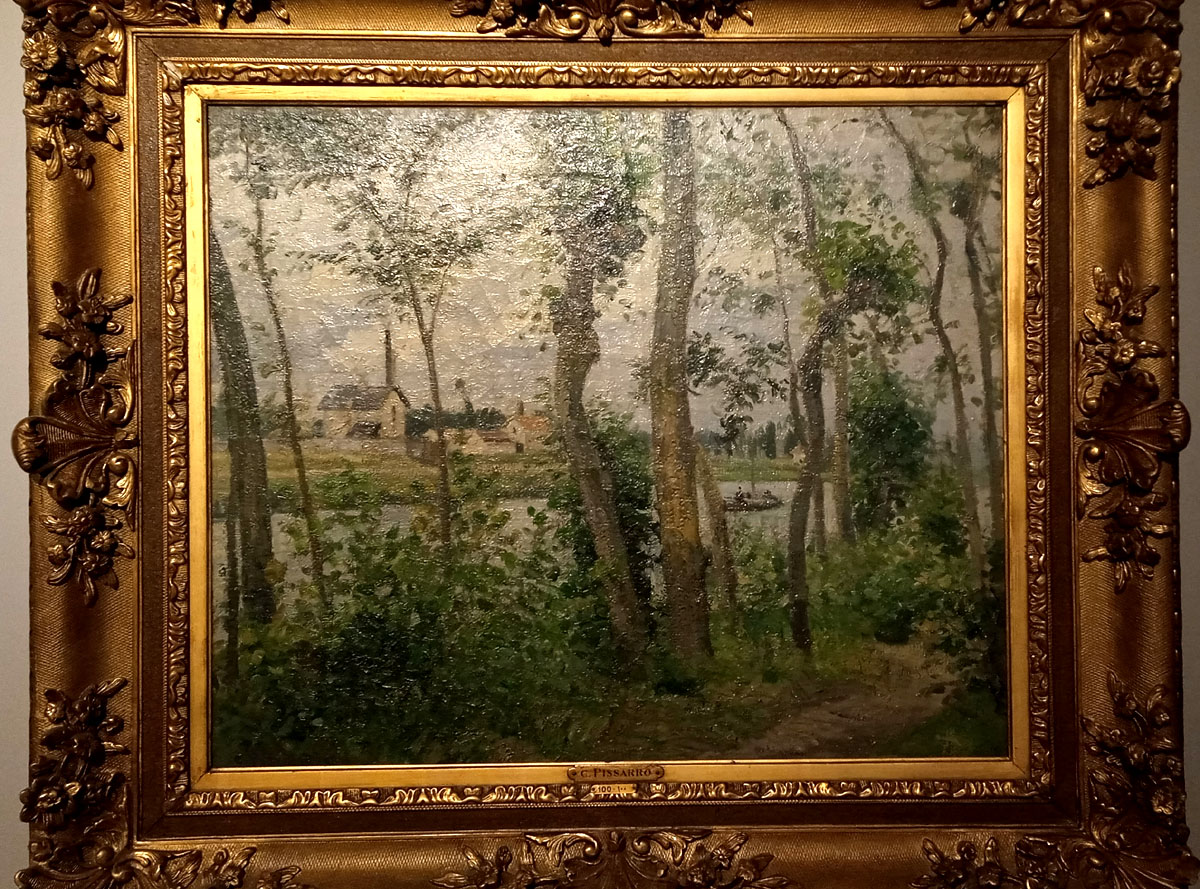

During the Franco-Prussian War, more than 1,000 of Pissarro’s paintings were ruined. Soldiers reportedly used some as floor mats to wipe their muddy boots.
In the 1930s, numerous others were looted by the Nazis.
Cricket at Bedford Park (above, top, 1897) shows cricket players and a crowd of spectators at a bright London park. The scene is depicted with loose brush strokes and striking summer light.
Banks of the Oise at Pontoise (above, bottom, 1874) shows a rustic scene of a river through the trees at Pontoise, the charming commune just outside Paris that Pissarro called home for 17 years. Pontoise was one of the capitals of the Impressionist movement and attracted painters looking for unspoilt nature.
11. The Renoirs
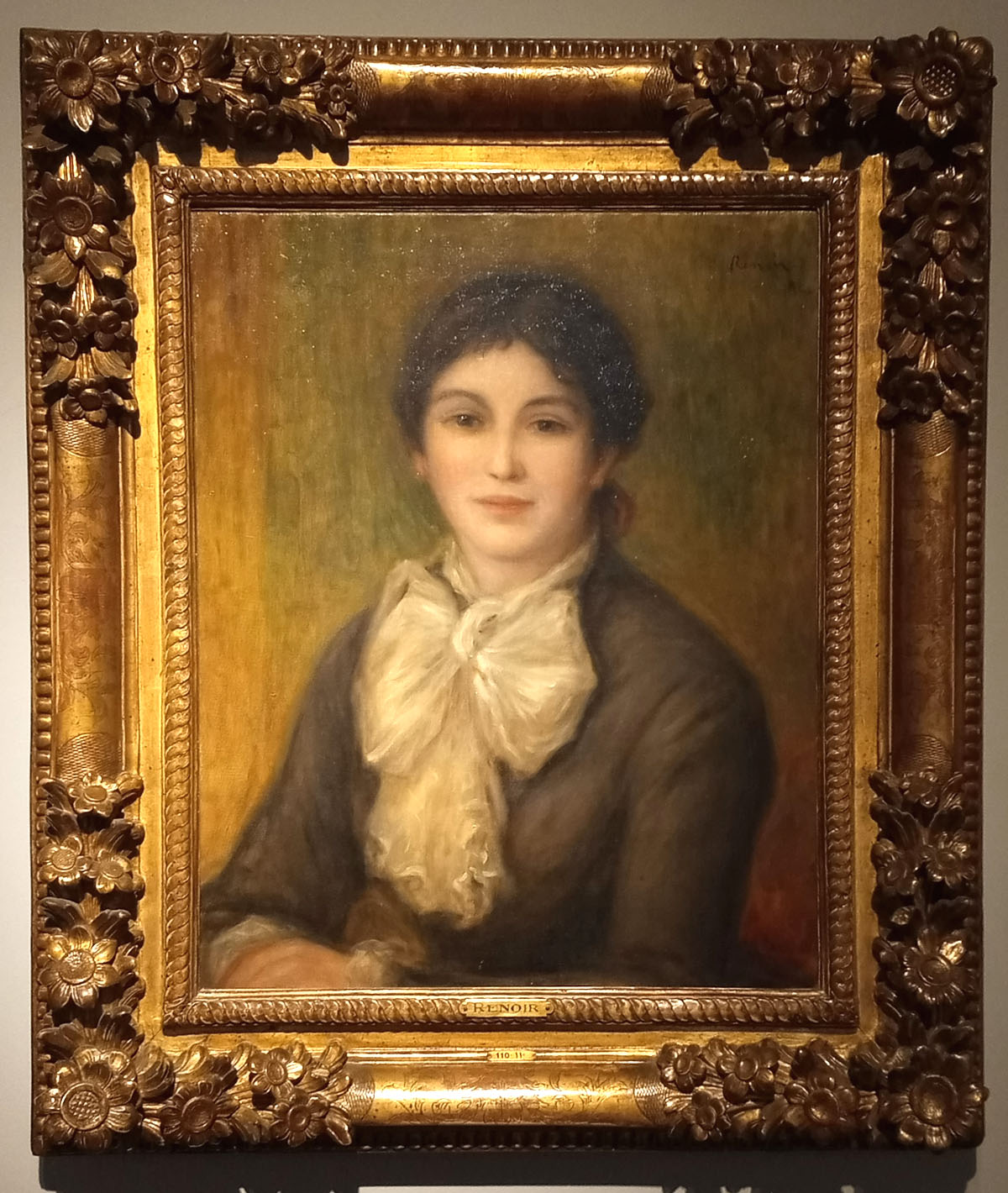

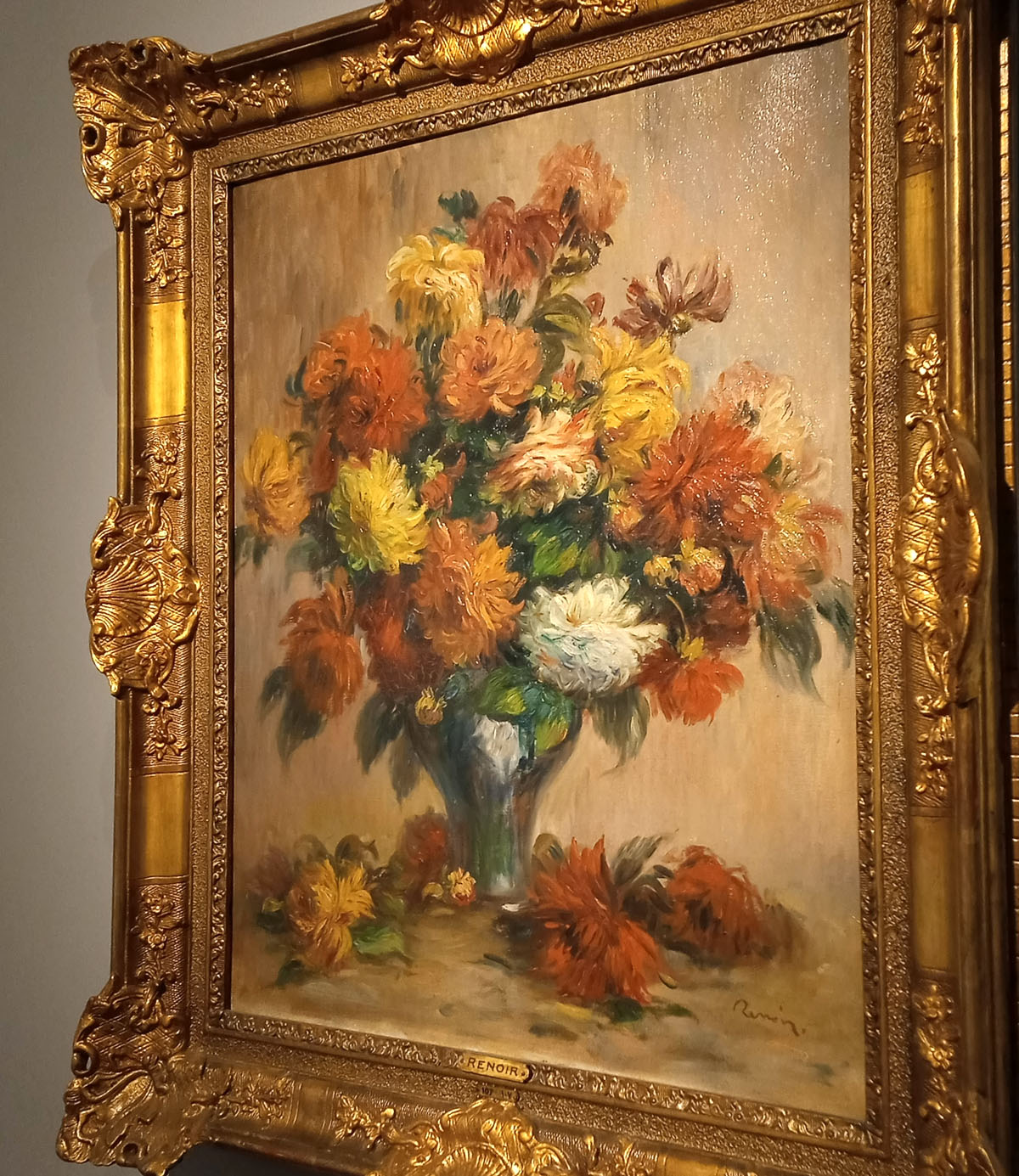

The Renoir collection is easily the top highlight at the Khalil Museum.
And if you only have a half hour for your visit, head straight to the top floor to admire this Impressionist master’s undulating brush strokes.
Pierre-Auguste Renoir (1841-1919) is known for the soft lines and warm sensuality in his nudes, portraits and snapshots of everyday Parisian life.
Woman With A White Neck Scarf (above, top, 1882) is an expressive portrait of a young woman in the flower of her youth. Her face is in focus against a softly-blurred background.
Dahlias (above, bottom) is a masterful still life done in bold colors and thick strokes. Renoir loved to paint still lives for a greater freedom to experiment. “When I paint flowers, I feel free to try out tones and values and worry less about destroying the canvas,” he said.
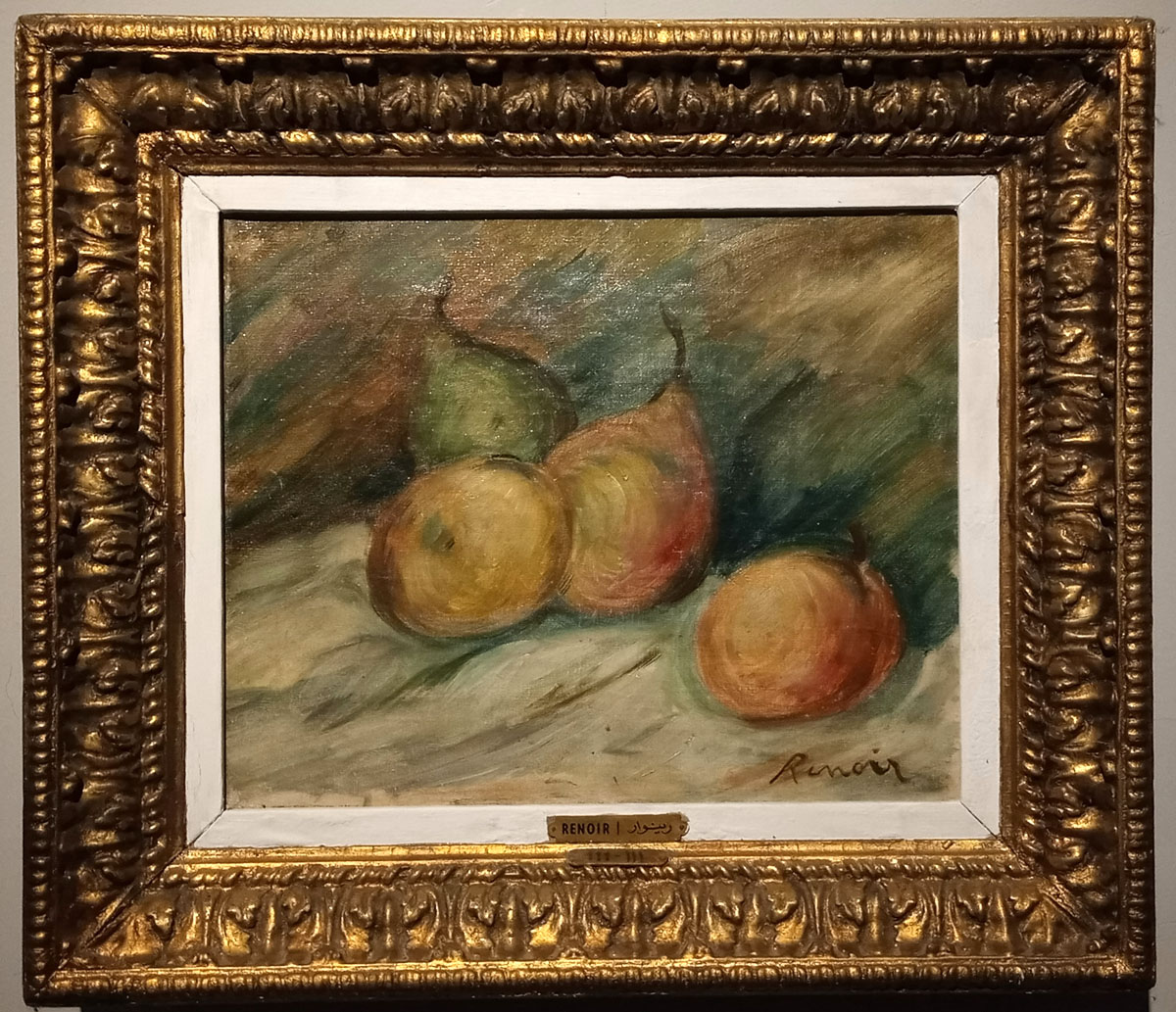

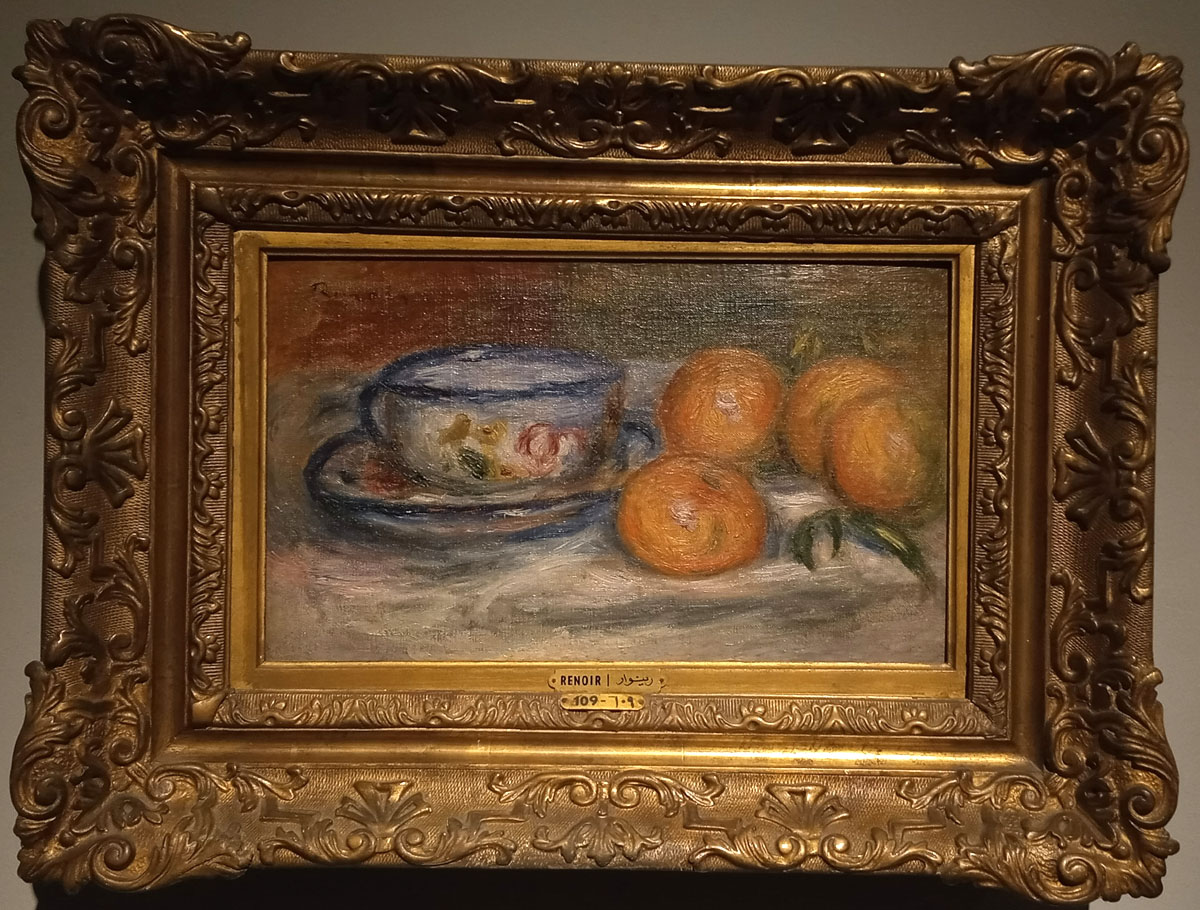

Still Life with Pears (above, top) and Still Life with a Cup and Mandarins (above, bottom) are both beautiful examples of Renoir’s watery brush work.
The strokes are sensual and wavy as if they were painted underwater.
And they’re an entirely different experience to view in real life (as opposed to art books).
The Khalil Museum offers a quiet venue to experience these Renoirs without the usual museum crowds.
12. The Delacroixs
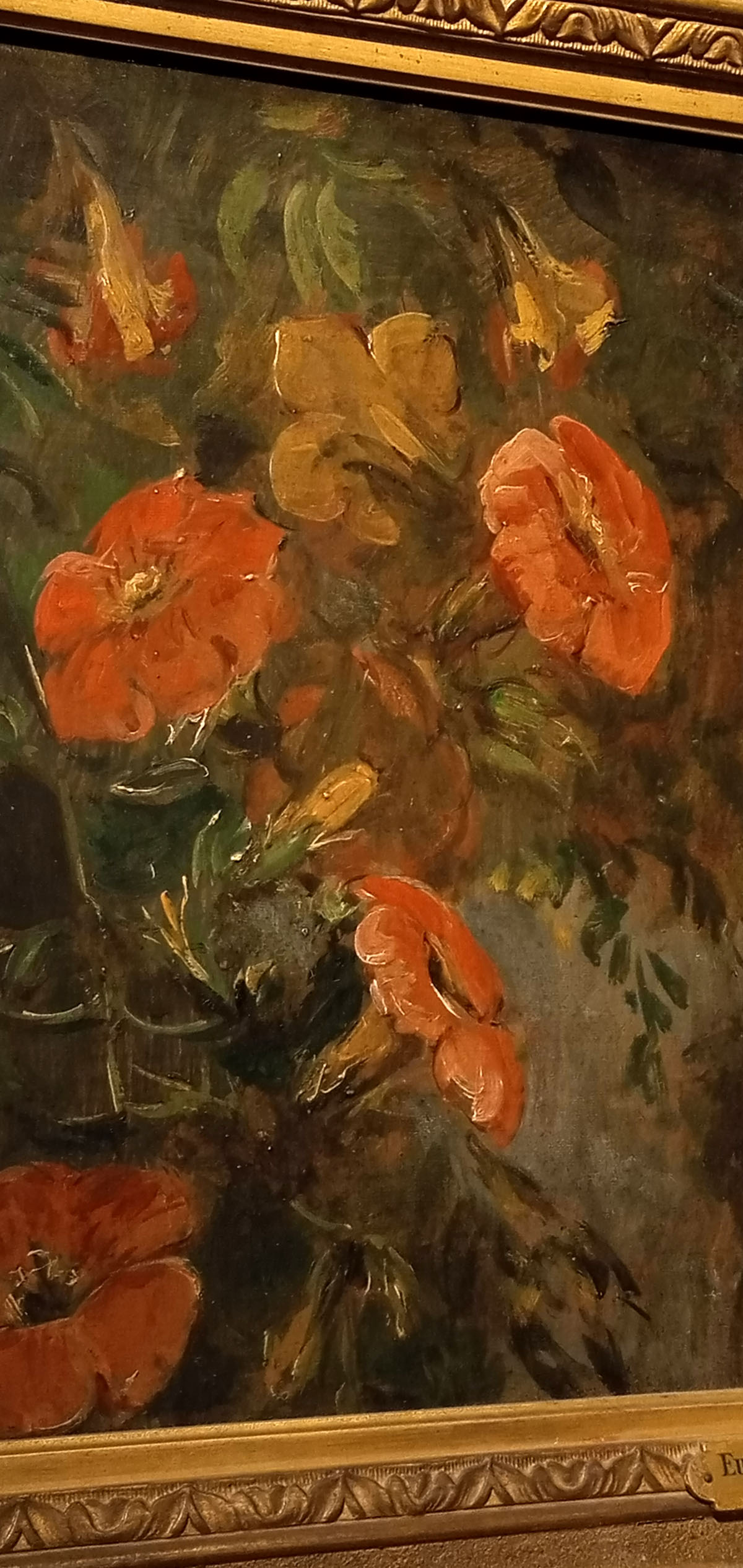

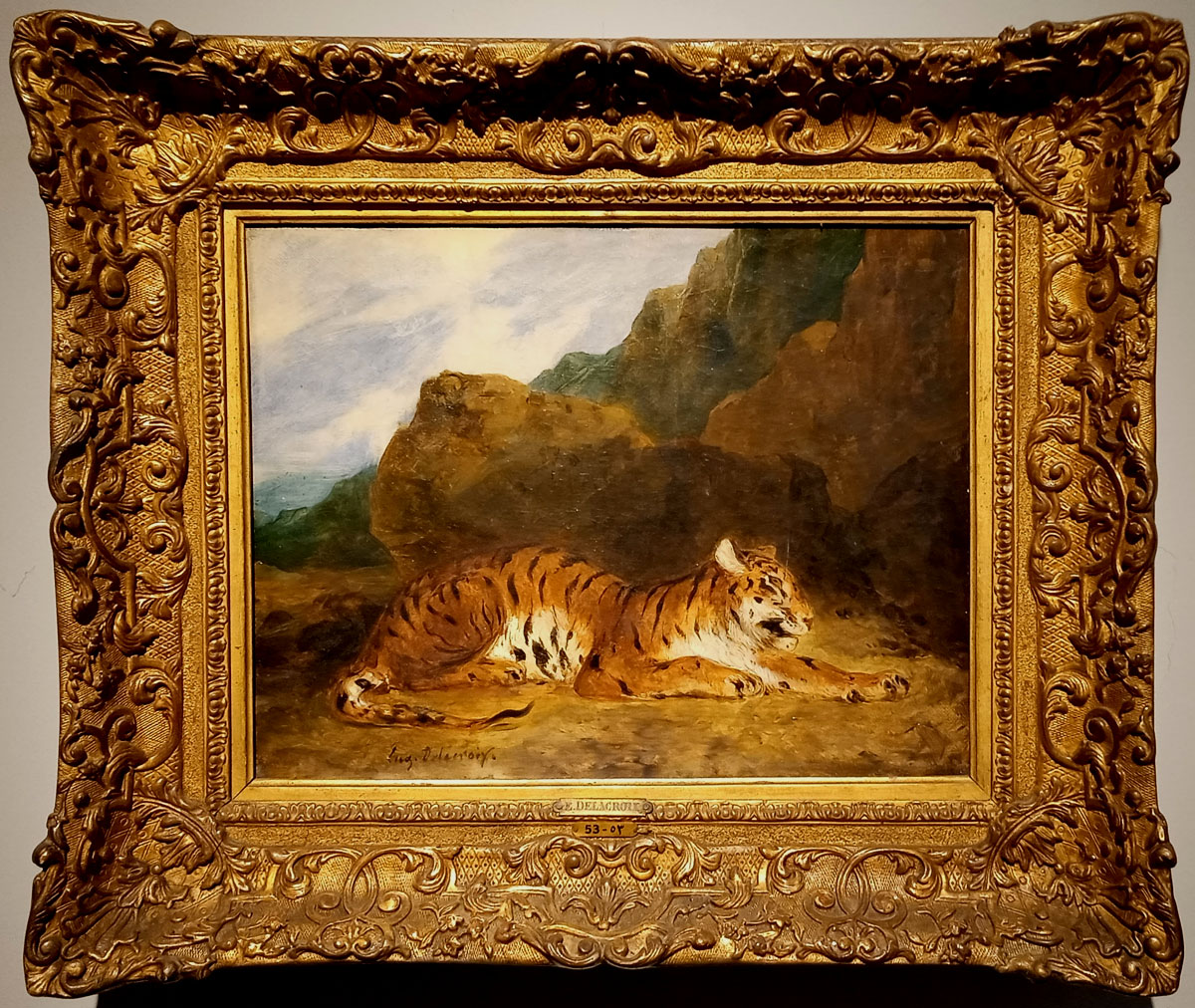

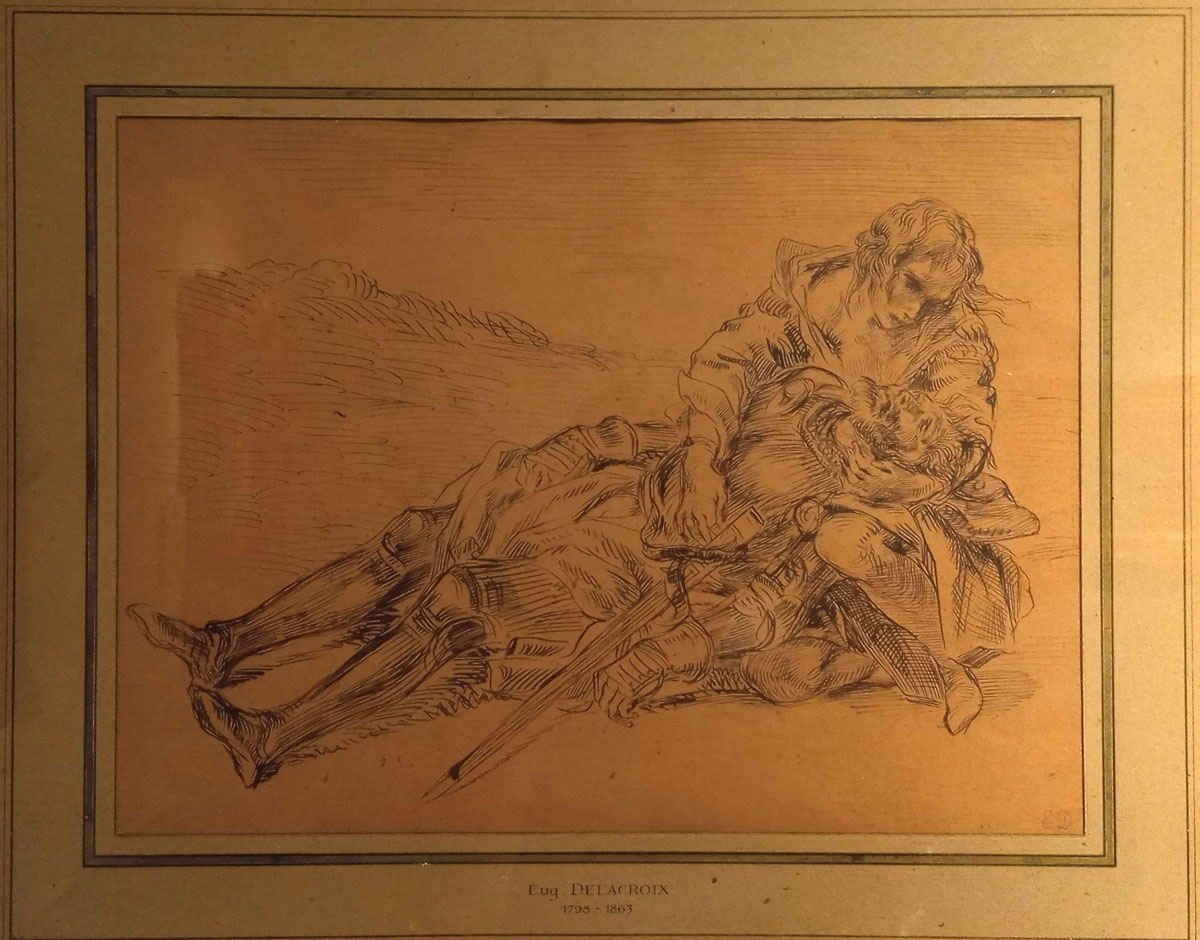

Delacroix is a Romantic artist who is profoundly influential for his emphasis on movement and color.
Considered one of the last old Masters, his expressive brushwork and palette greatly influenced the Impressionist movement.
His best-known painting is Liberty Leading the People, which depicts a female figure leading warriors onward during the French Revolution.
Delacroix traveled widely across Andalusia, Morocco and Algeria, where he kept a journal filled with brilliant travel sketches. He even managed to secretly draw some women in Algiers.
Flower Study with Wisteria (above, top) shows Delacroix’s use of expressive colors and contrast – from the bright yellows in the foreground to the deep purples of the wisteria.
Tiger (above, middle) is a beautiful study of movement in bright colors. Delacroix loved to sketch lions and tigers at the Jardin des Plantes in Paris, where he observed the coats and shapes of the exotic creatures.
Study of a Dying Warrior (above, bottom) shows off Delacroix’s brilliant line work, which he used to make quick observations during his travels. The drawing also shows his dedication to his craft. Delacroix filled numerous sketchbooks with his quick studies and watercolors.
Conclusion
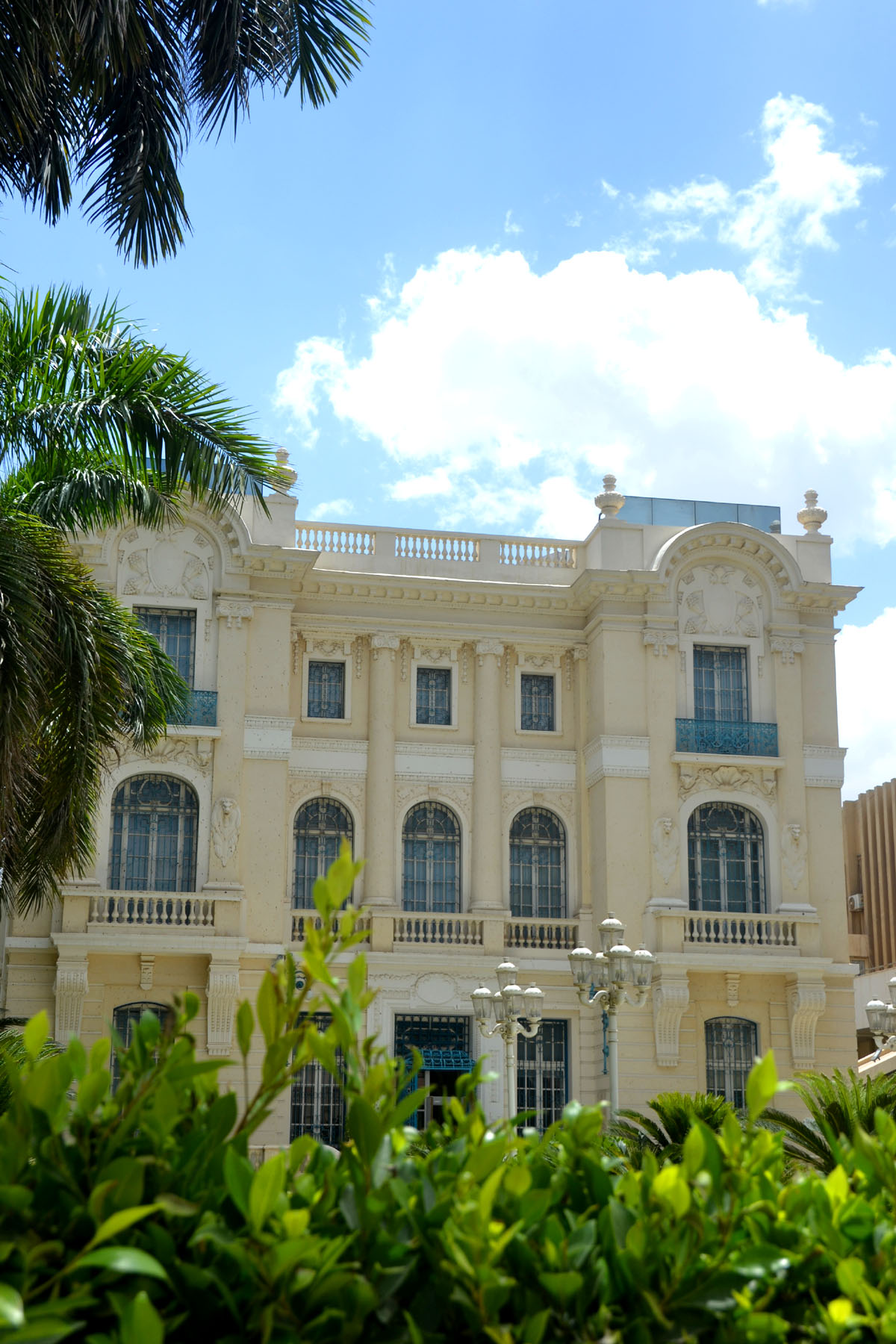

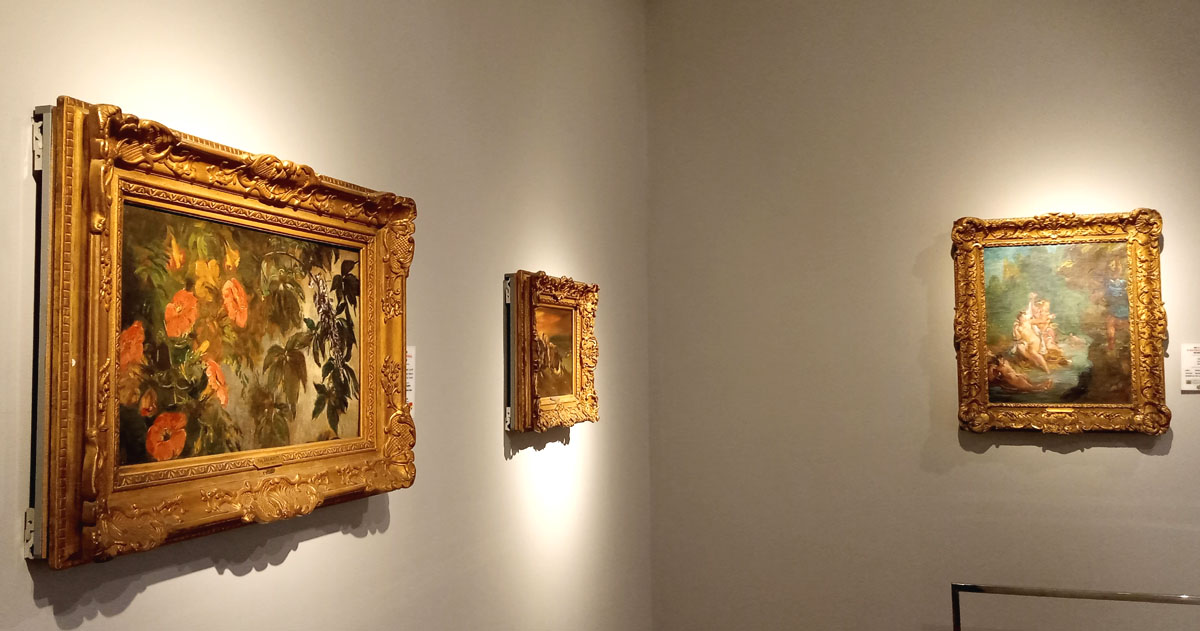

With a gorgeous collection of Impressionist paintings, the Khalil Museum is a must-see in Cairo for any arts lover.
And despite its annoying security intercom, the museum is relatively quiet and never gets too crowded.
It’s an idyllic setting alongside the Nile – and a great spot to experience Cairo off the beaten path.
I would love to hear from you. Have you visited the Khalil Museum yet?
MORE RESOURCES:
25 Best Things To Do In Cairo (A Local’s Guide!)
4 Best Things To Do On The Nile River In Cairo
The Perfect One-Day Cairo Itinerary (A Local’s Guide!)
Where To Stay In Cairo (An Ultimate Local’s Guide)
12 Must-See Hidden Gems in Cairo (A Local’s Guide)
Pin it:
